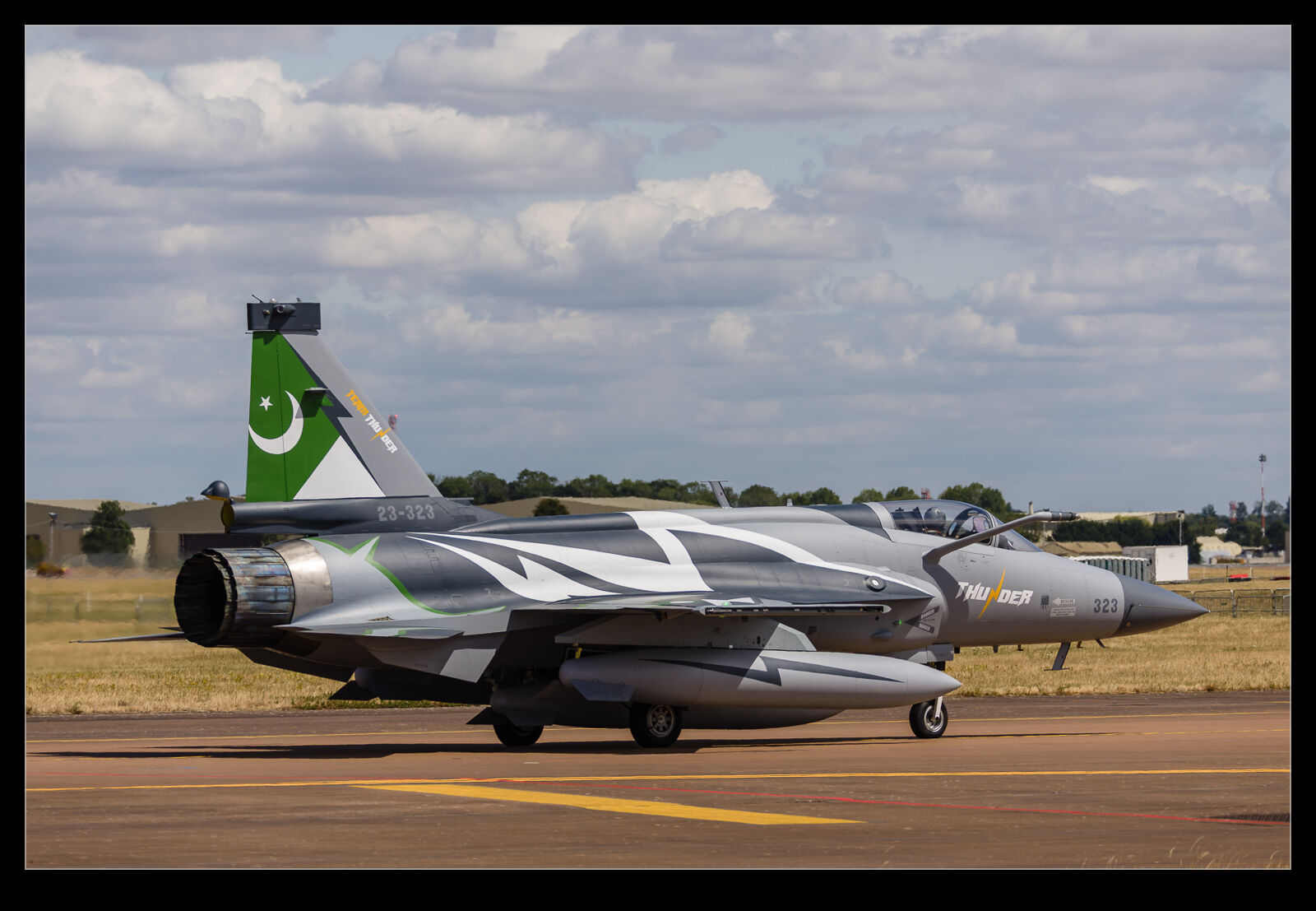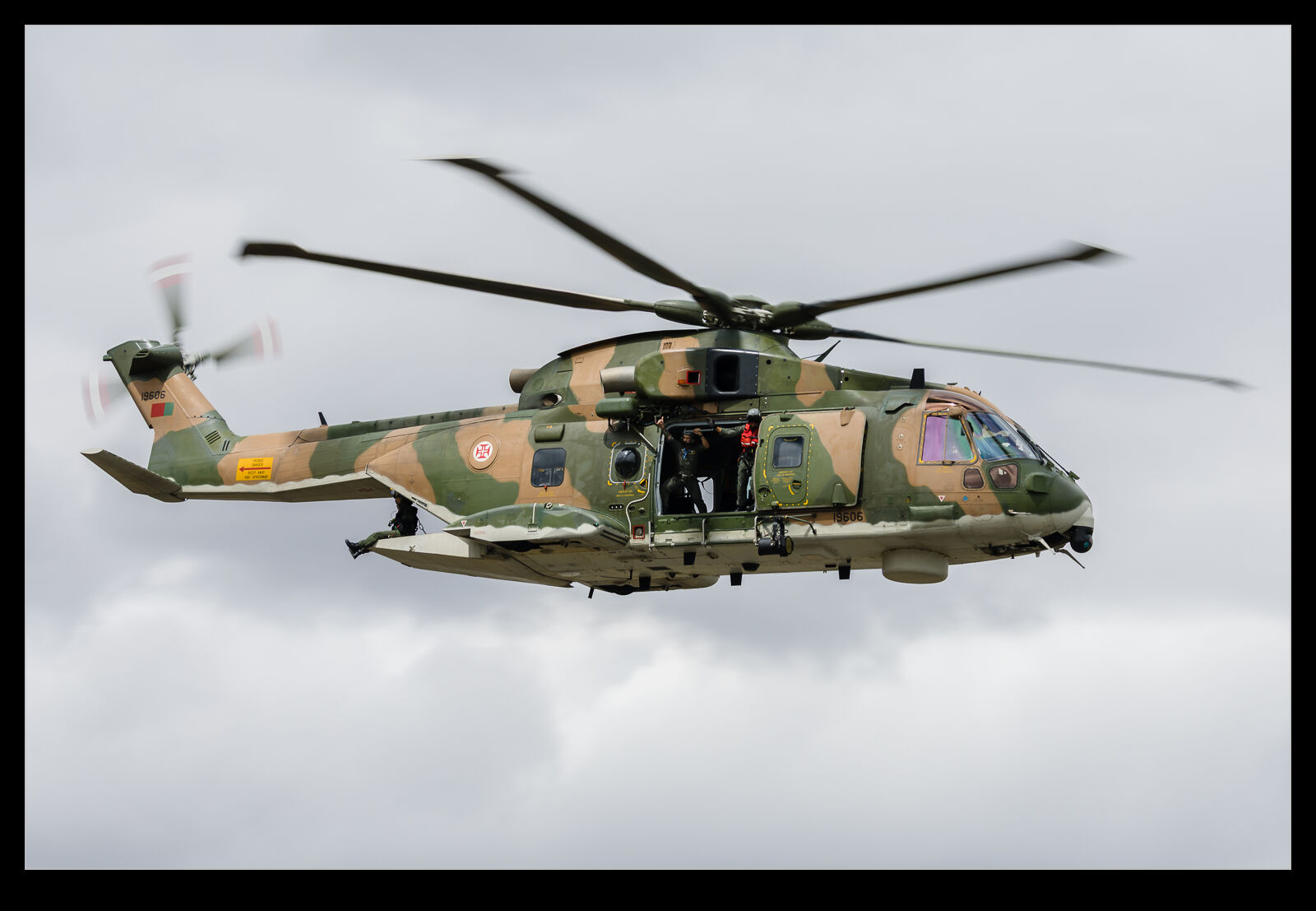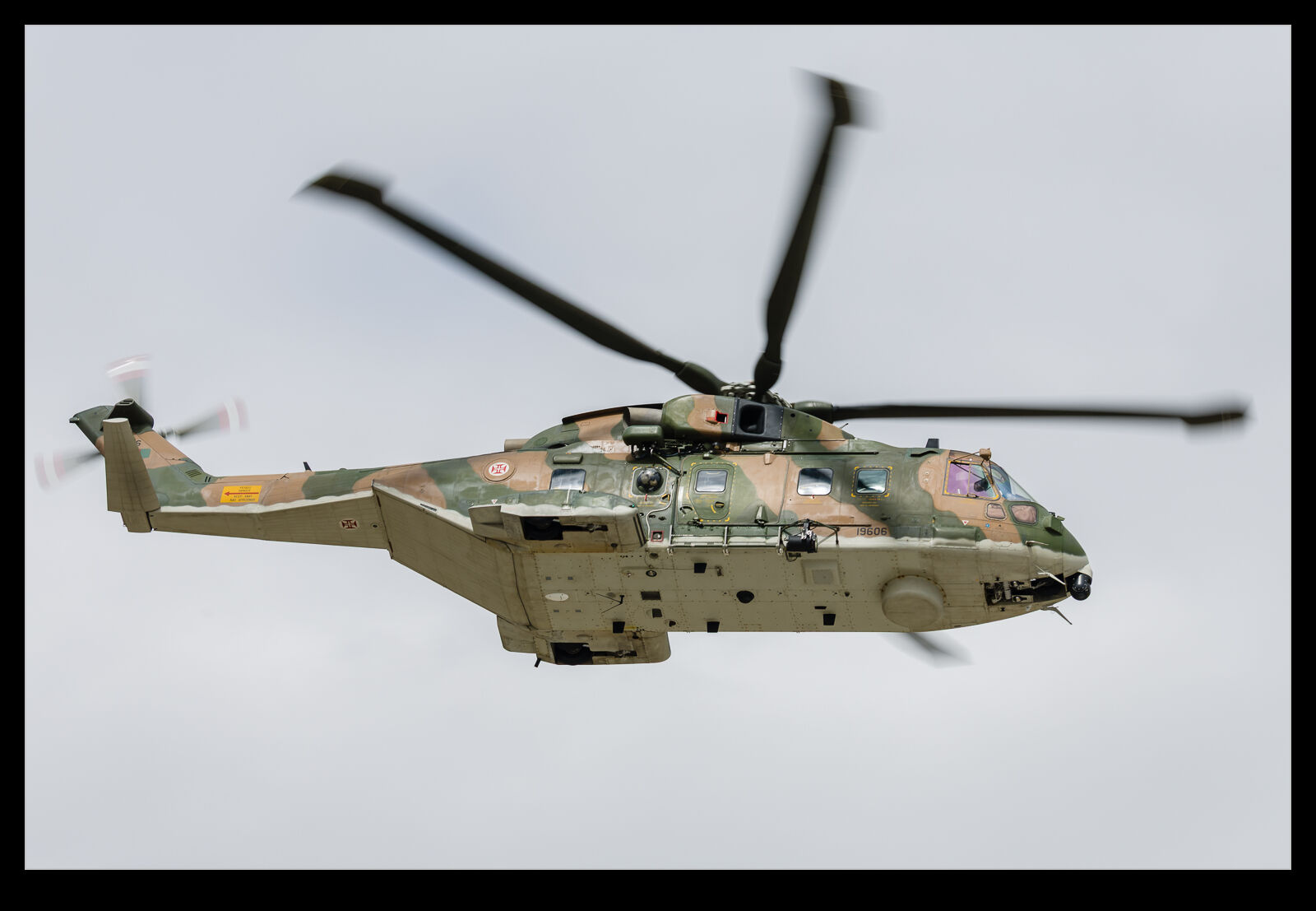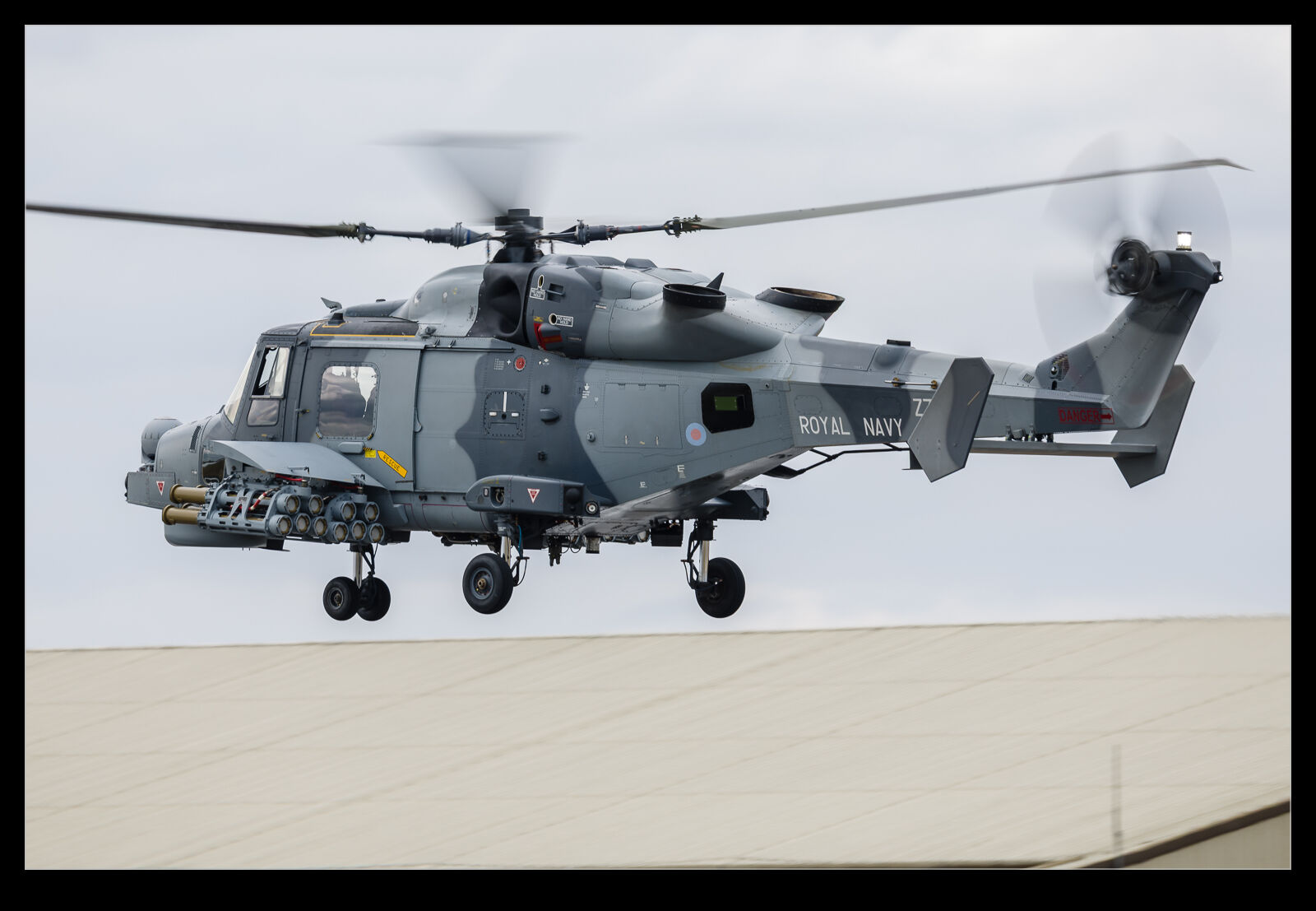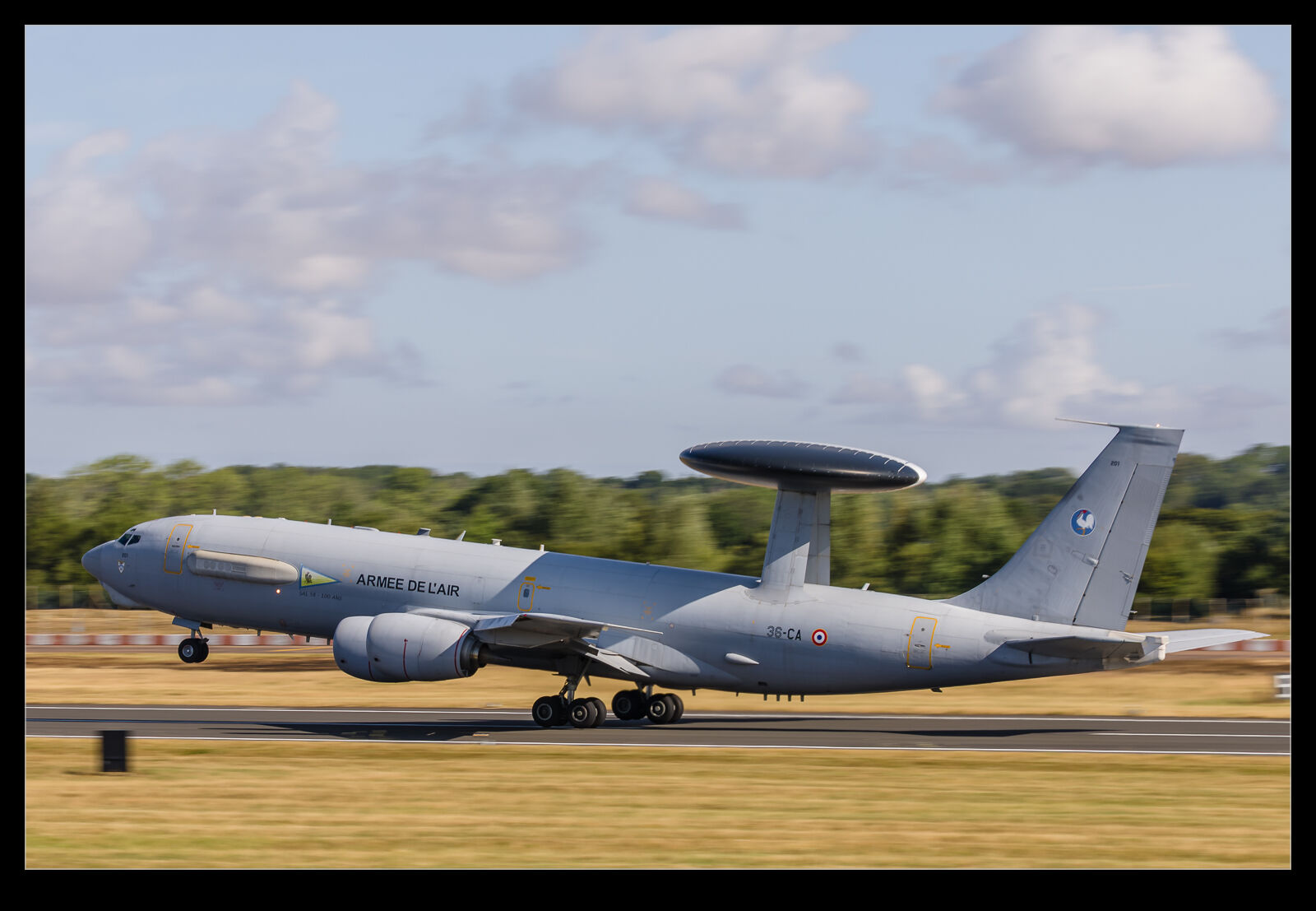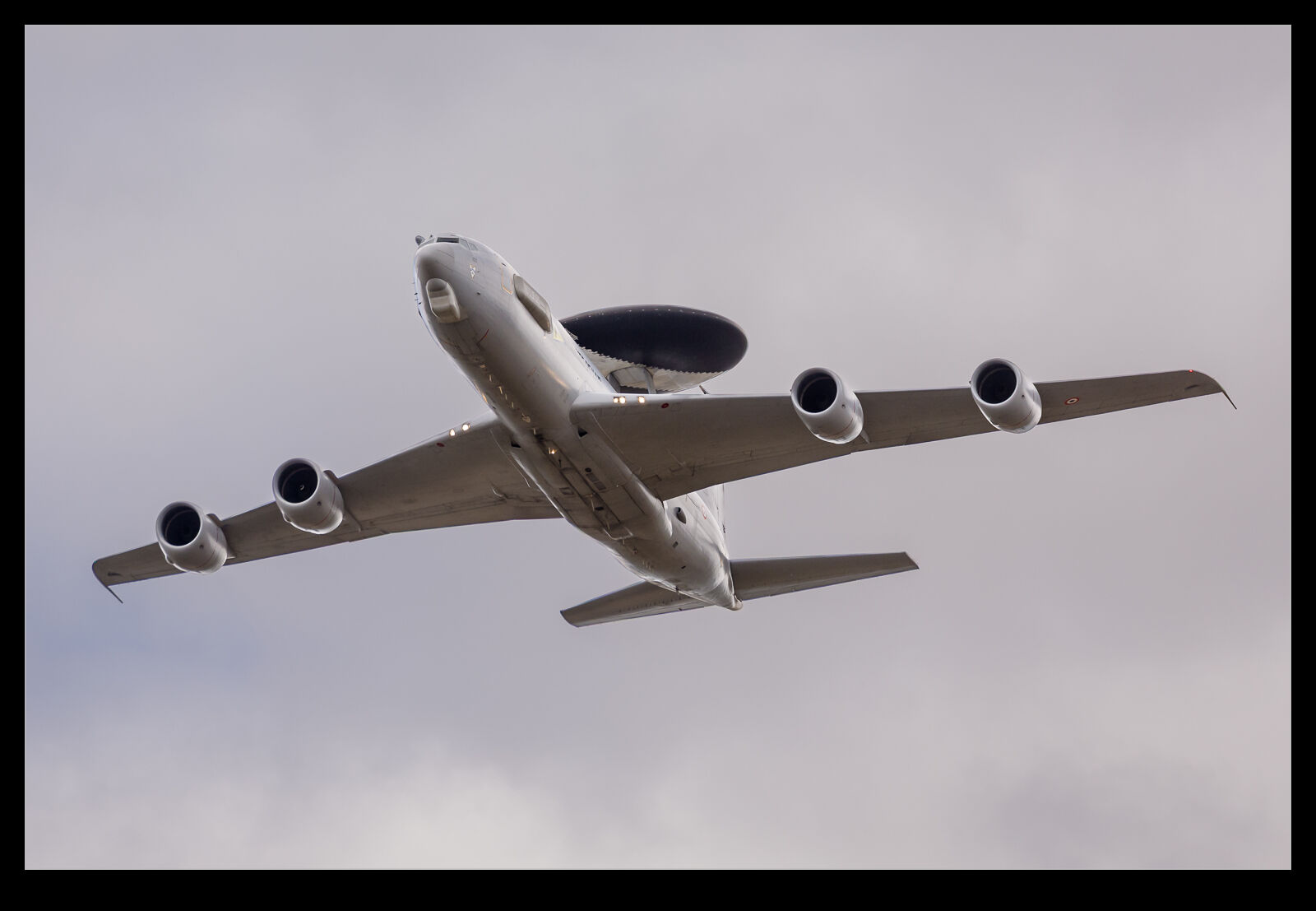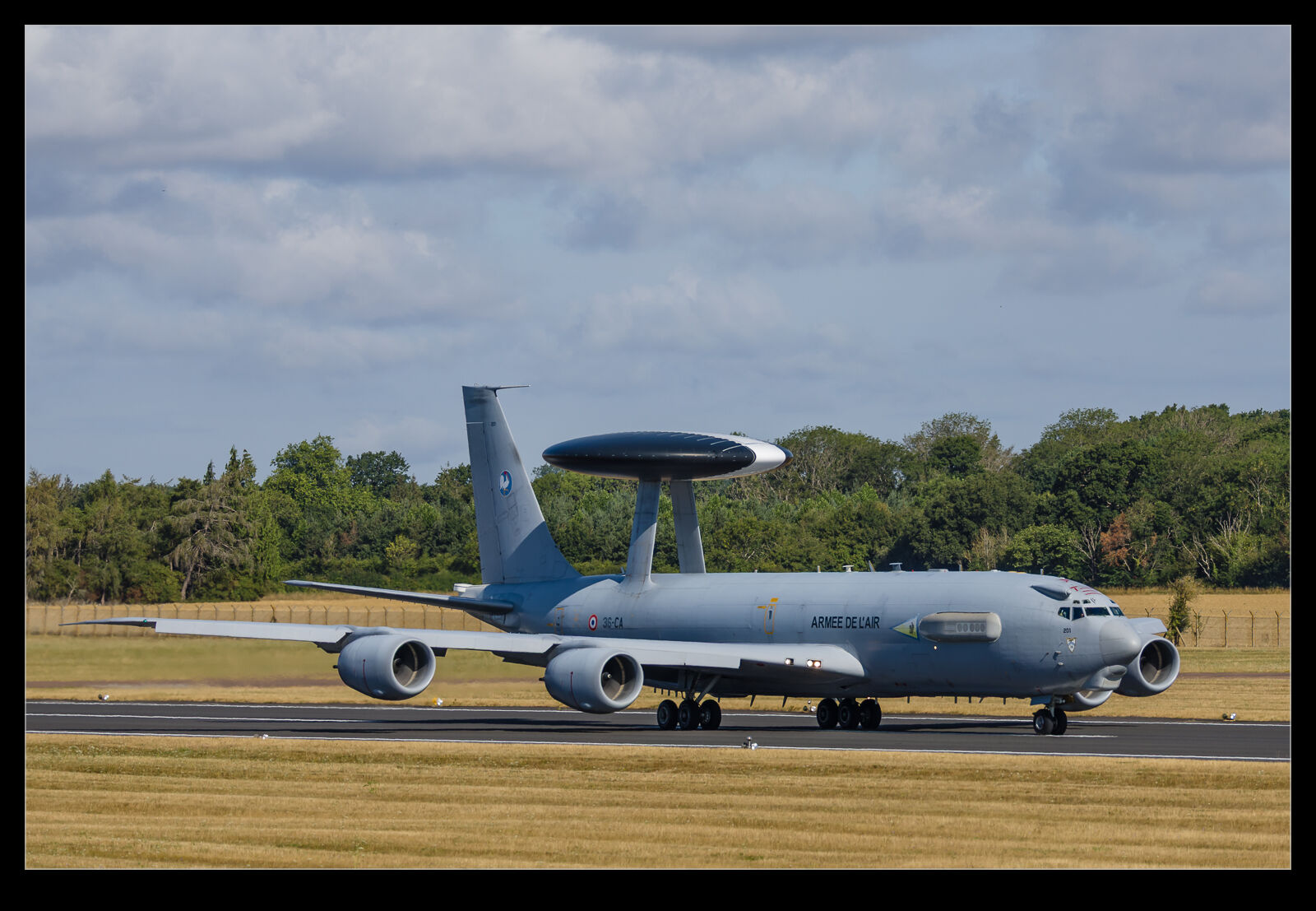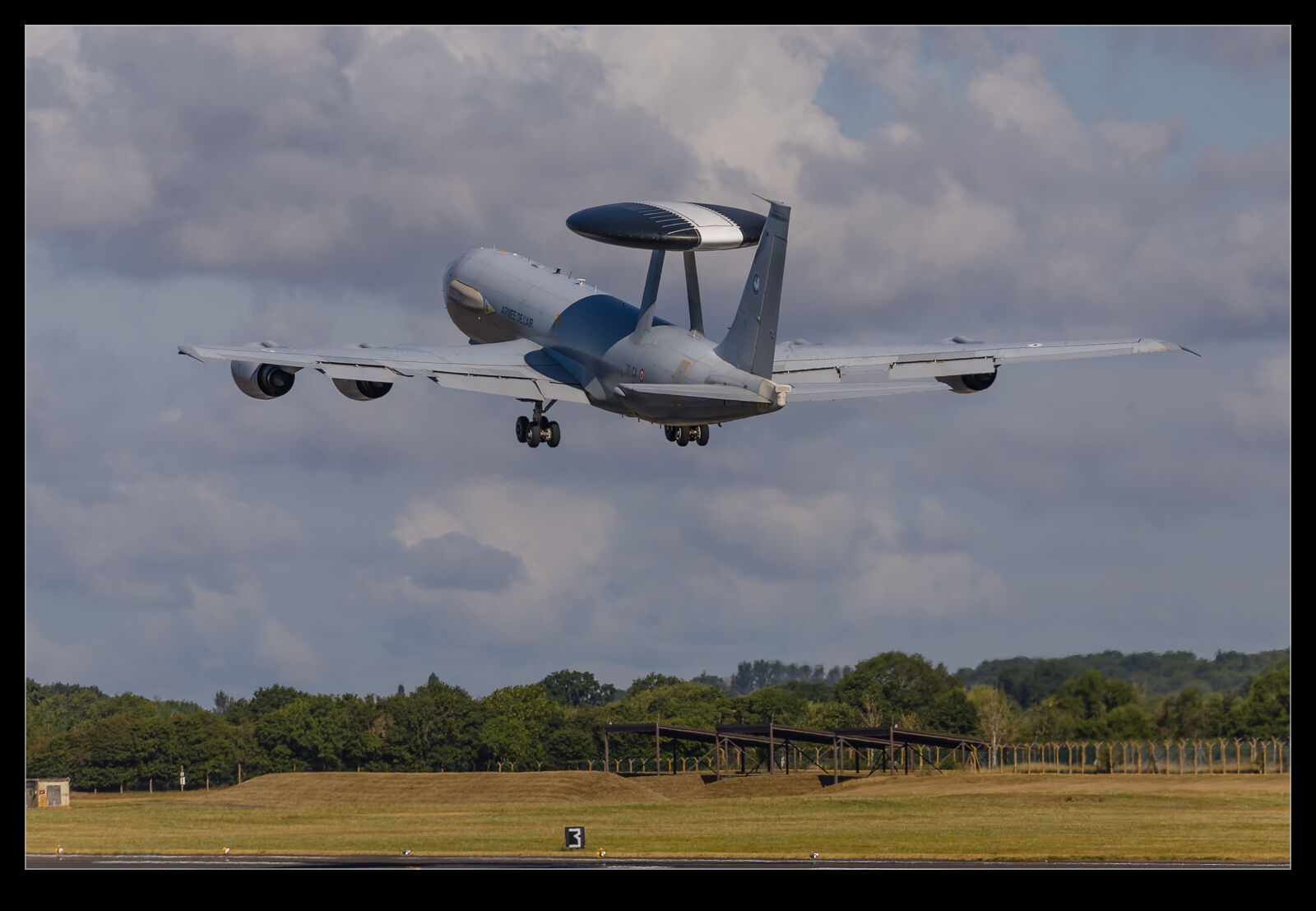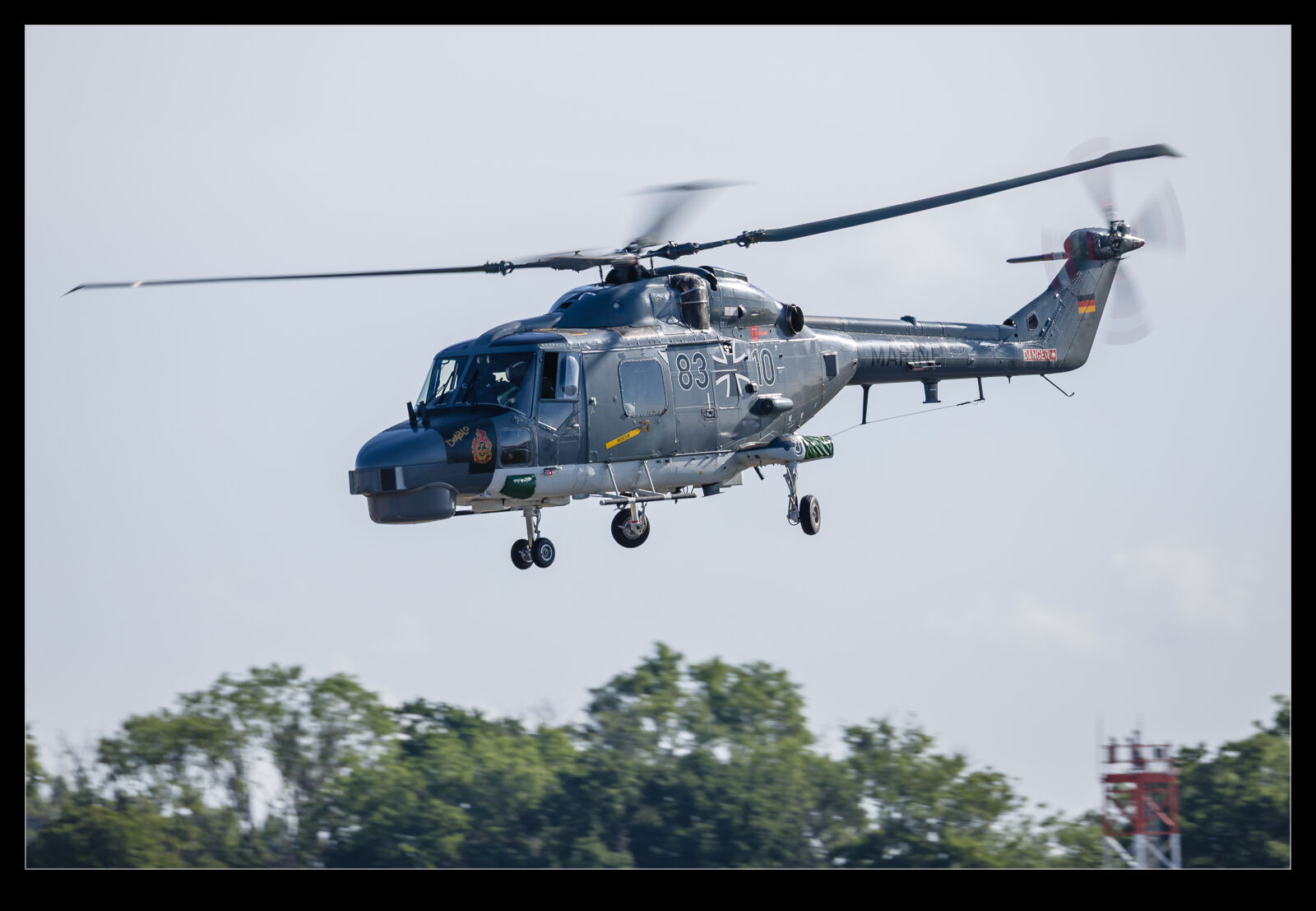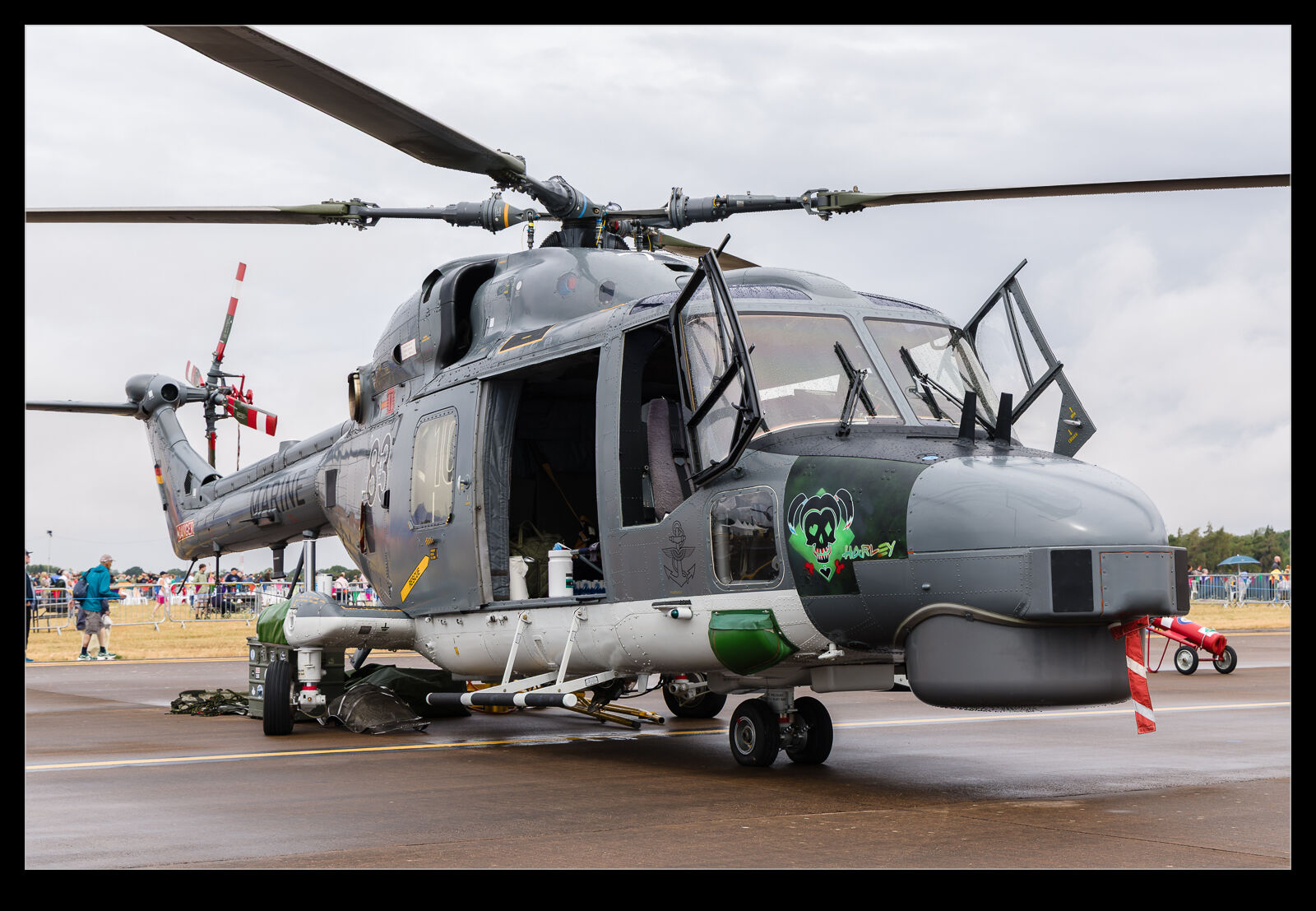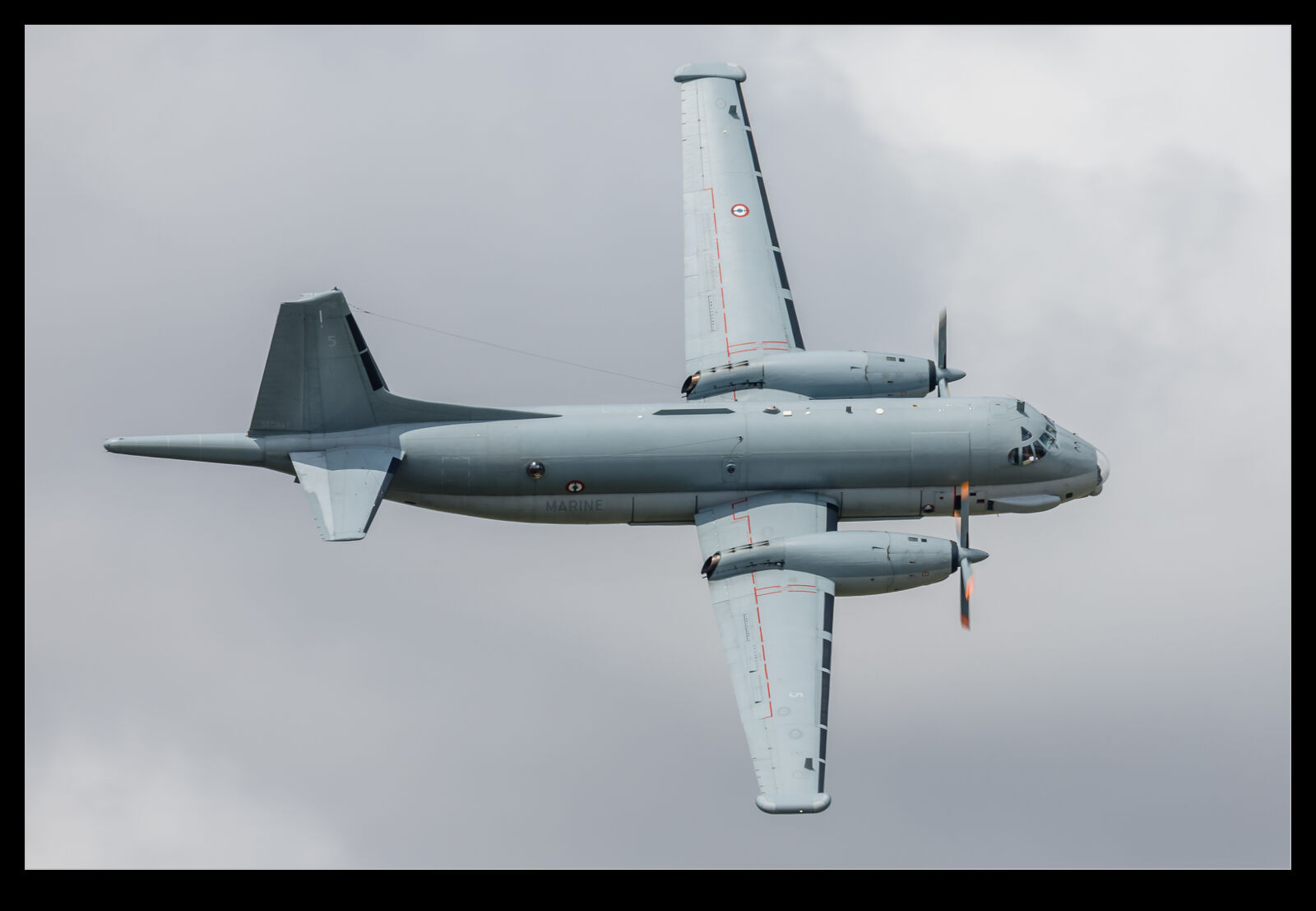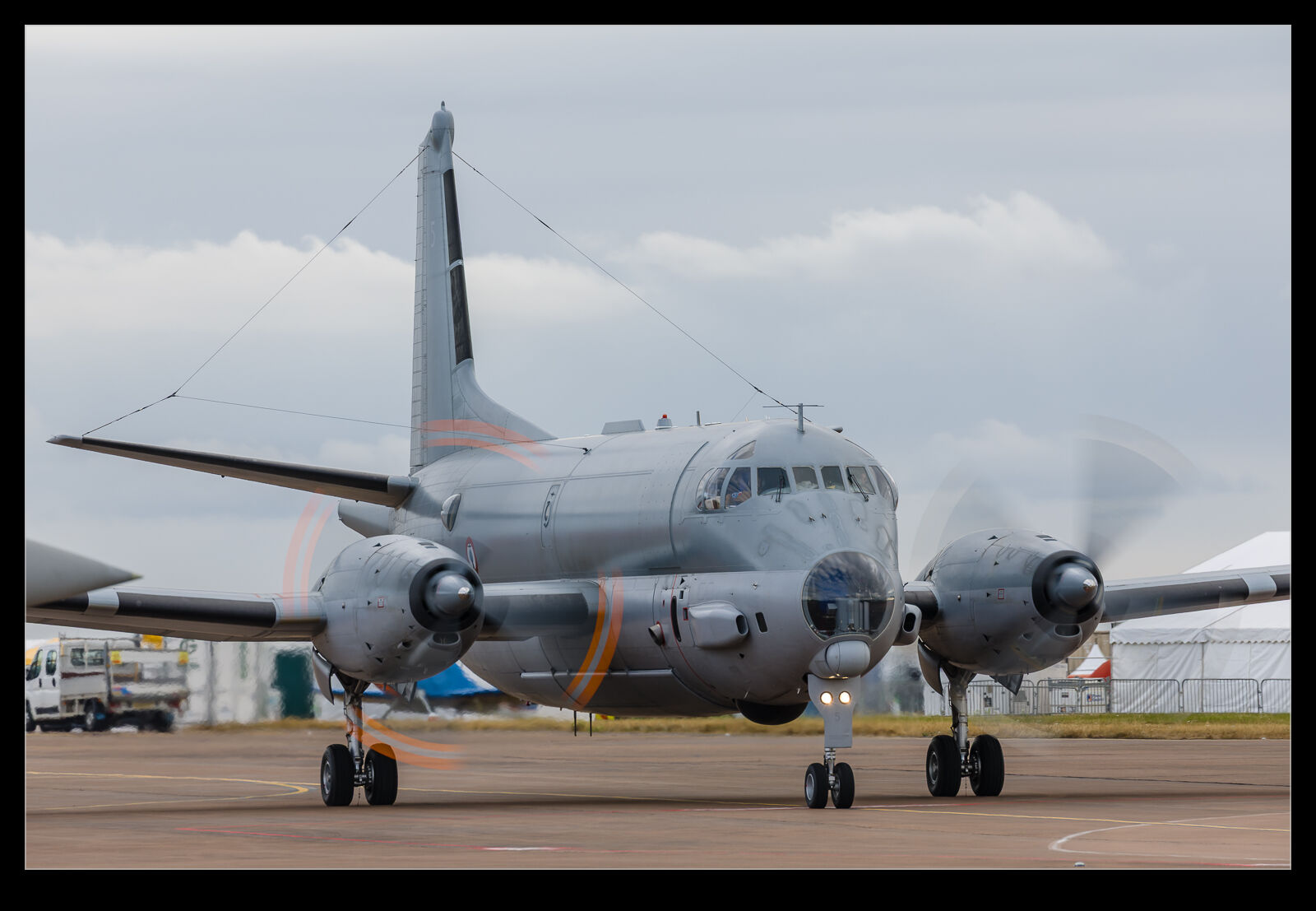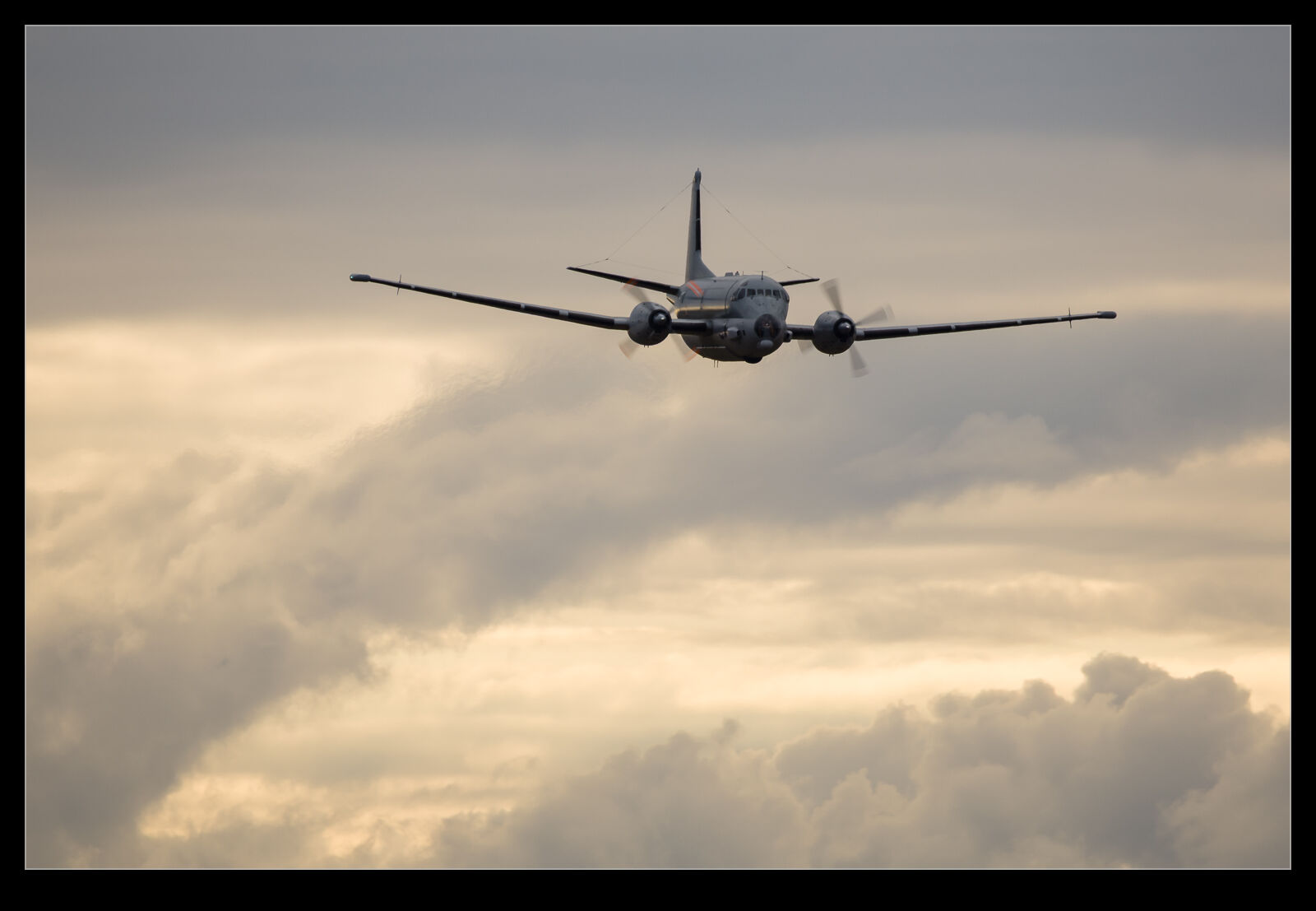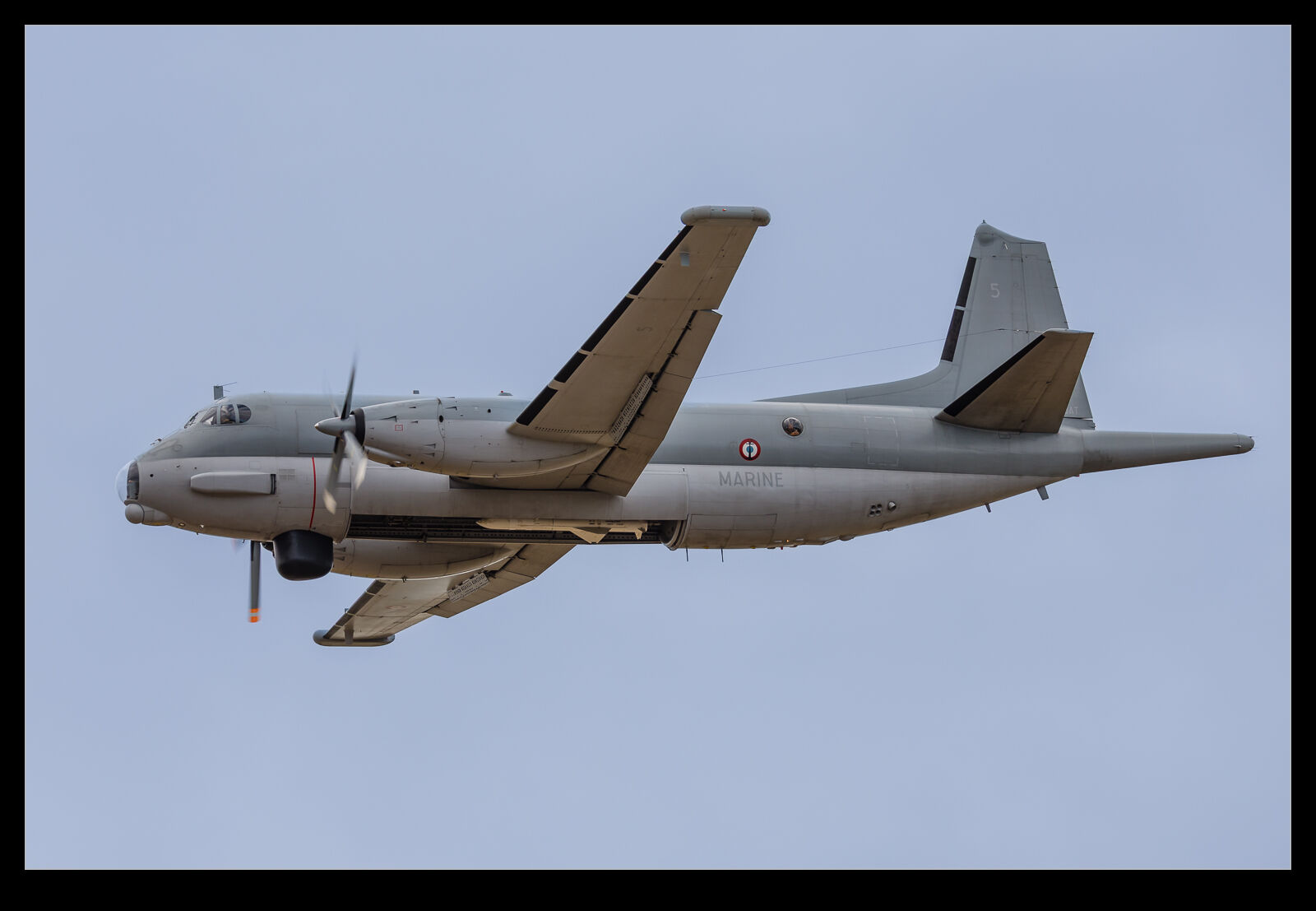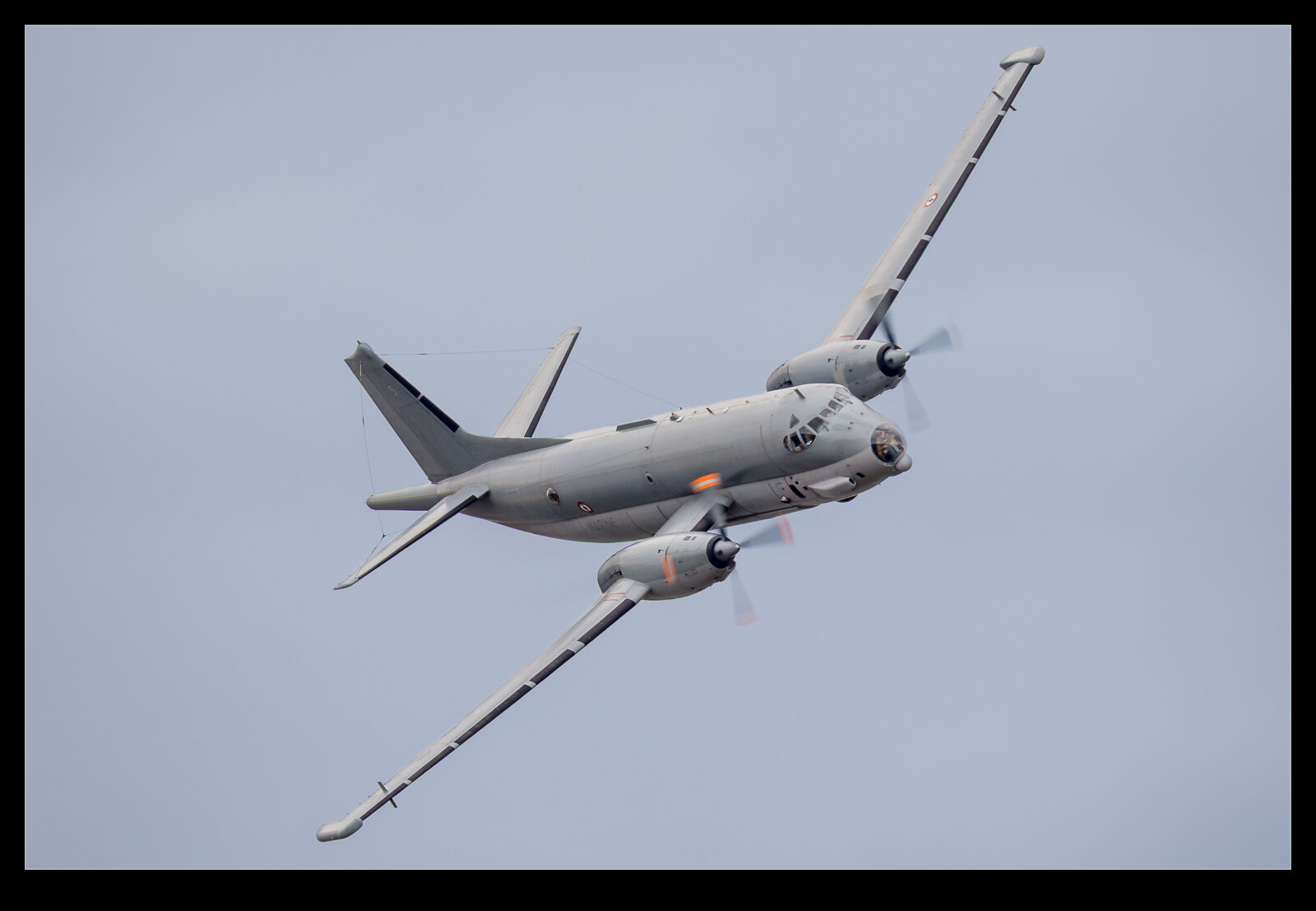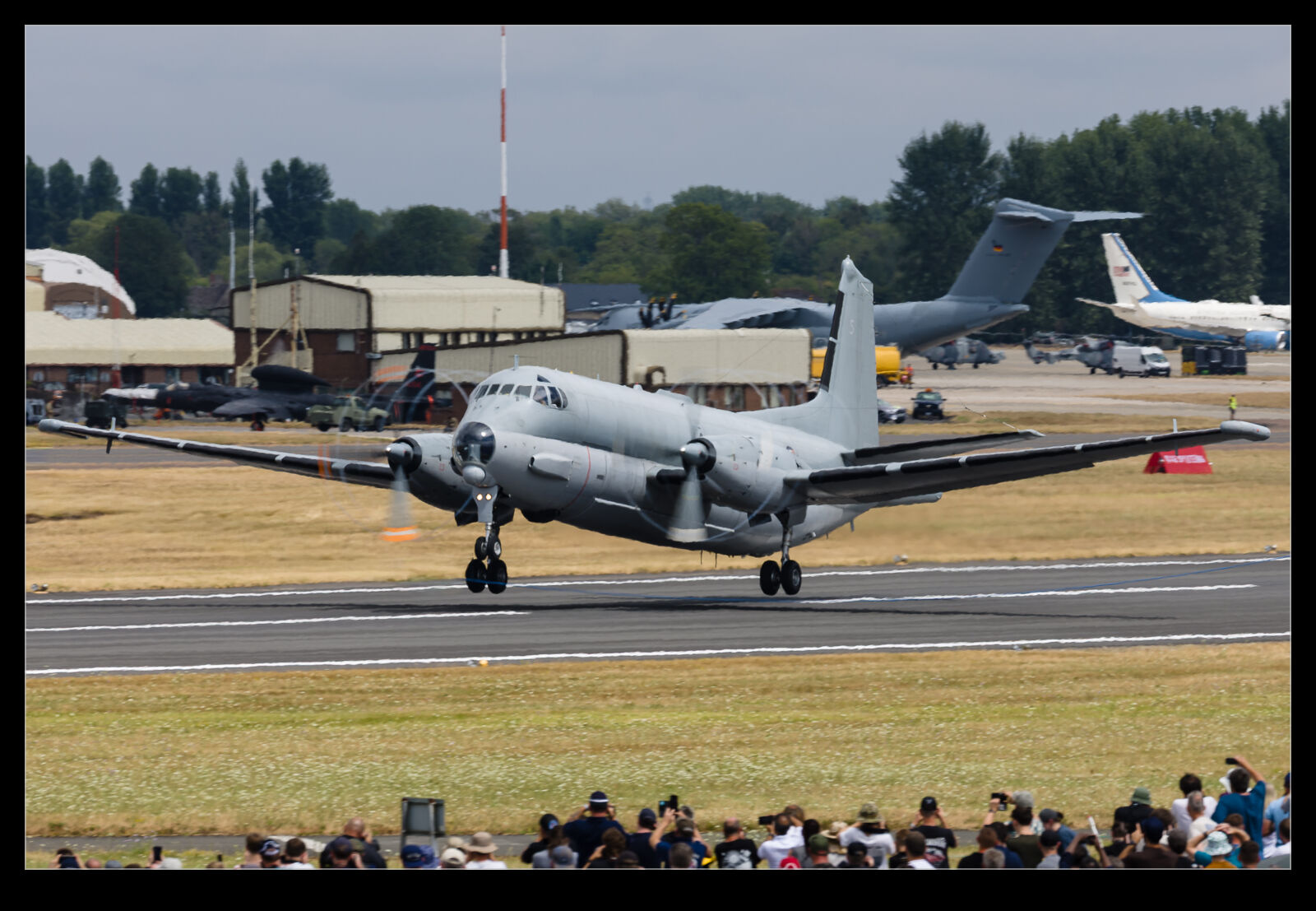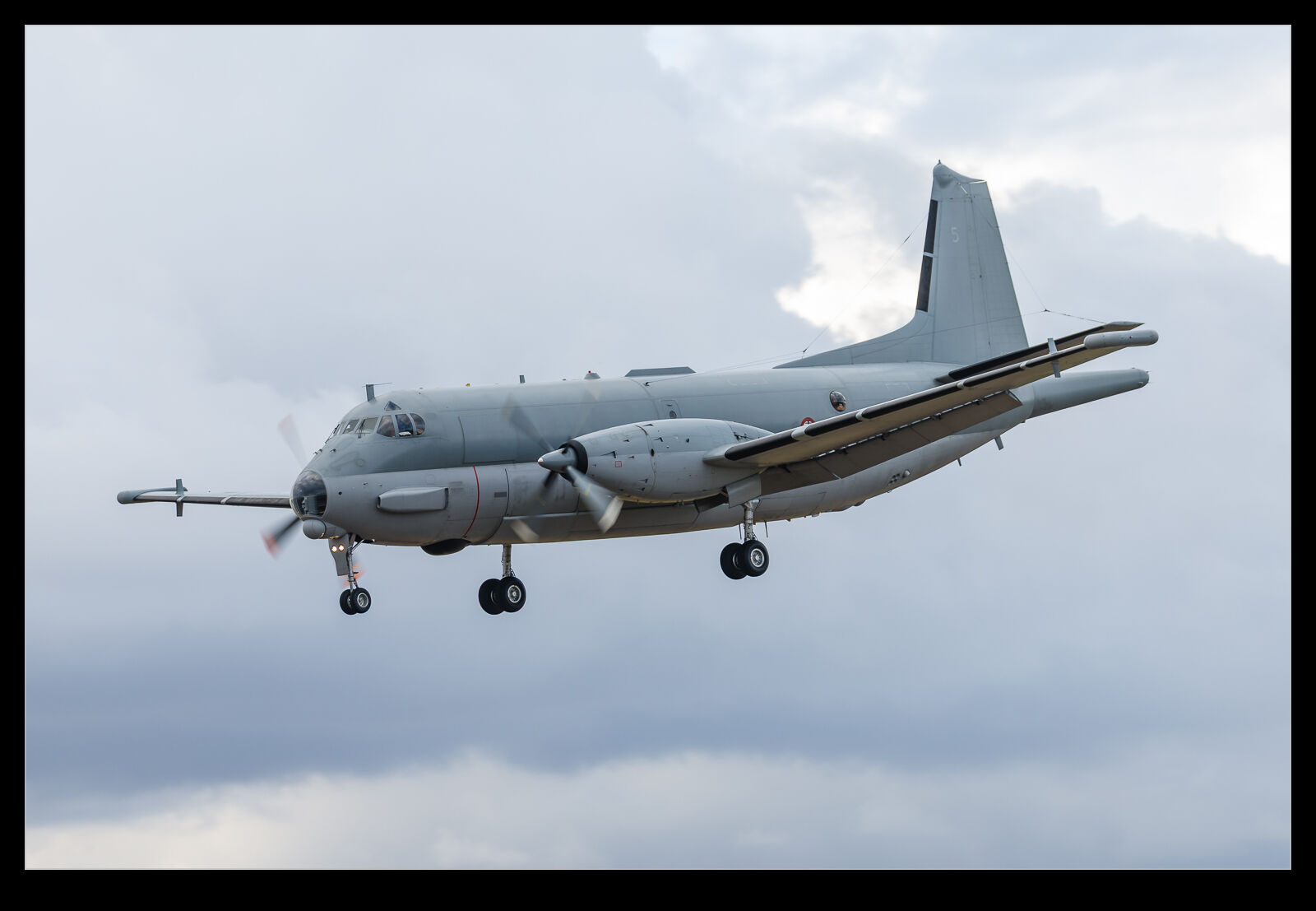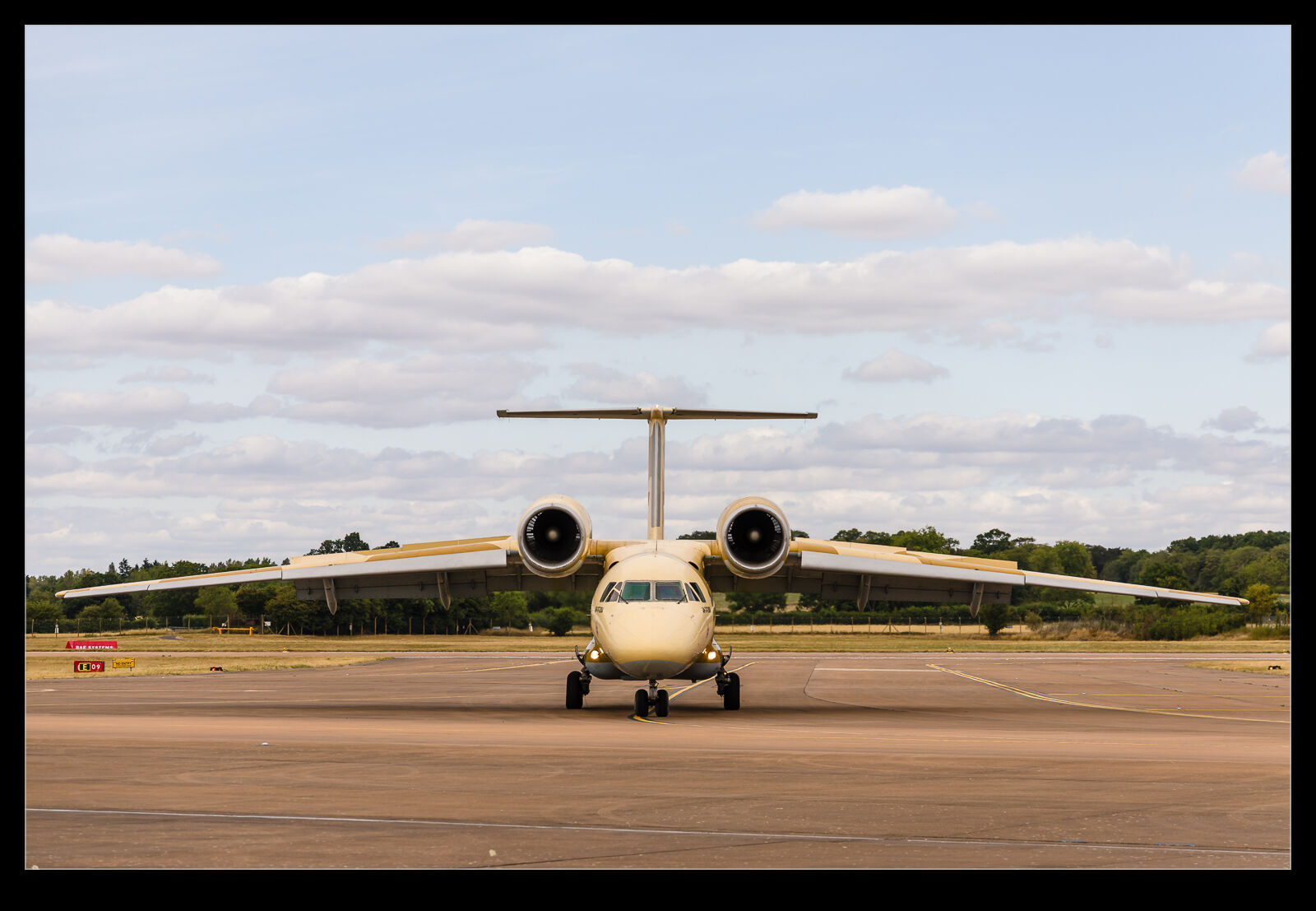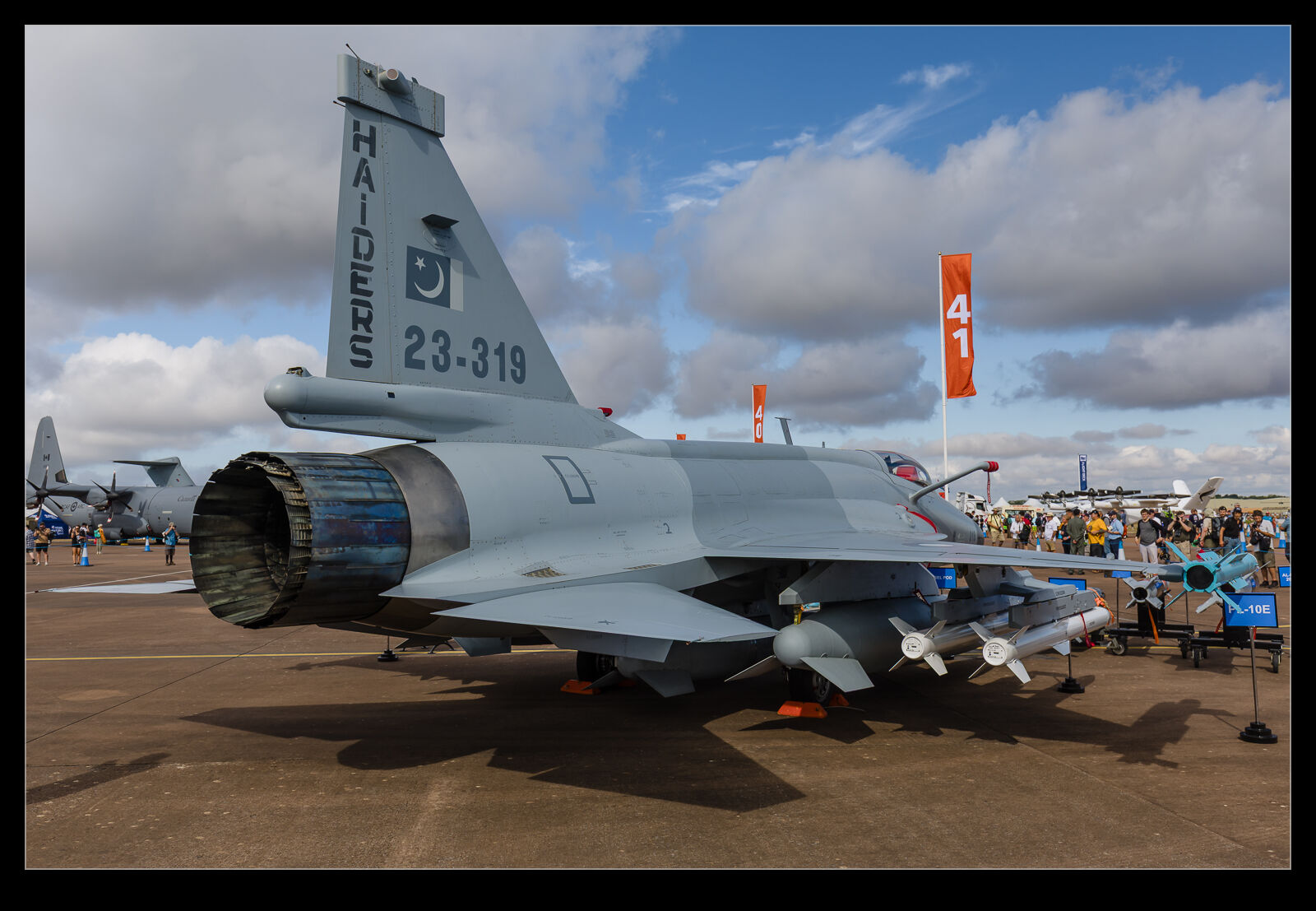 The JF-17 Thunder was one of the interesting aircraft to make it to RIAT in 2025. It had been before, but this was the first time I got to see it. The Pakistan Air Force brought a pair of them. I got to have a good look at one of them in the static park and something struck me about it. The engine installation. The plane is fitted with the Klimov RD93 engine which is a derivative of the engine for the MiG-29. The diameter of the nozzle for the engine seems to be very small compared to the rear fuselage size. Afterbody drag is a big deal on fighters and I wonder how bad the penalty is for this configuration. I understand that China is developing an engine to replace the RD93 and maybe the sizing of the fuselage is for this new engine. In the meantime, it does look like someone made do with the engine available.
The JF-17 Thunder was one of the interesting aircraft to make it to RIAT in 2025. It had been before, but this was the first time I got to see it. The Pakistan Air Force brought a pair of them. I got to have a good look at one of them in the static park and something struck me about it. The engine installation. The plane is fitted with the Klimov RD93 engine which is a derivative of the engine for the MiG-29. The diameter of the nozzle for the engine seems to be very small compared to the rear fuselage size. Afterbody drag is a big deal on fighters and I wonder how bad the penalty is for this configuration. I understand that China is developing an engine to replace the RD93 and maybe the sizing of the fuselage is for this new engine. In the meantime, it does look like someone made do with the engine available.
Tag Archives: Royal International Air Tattoo
Throwing a Transport Around the Sky
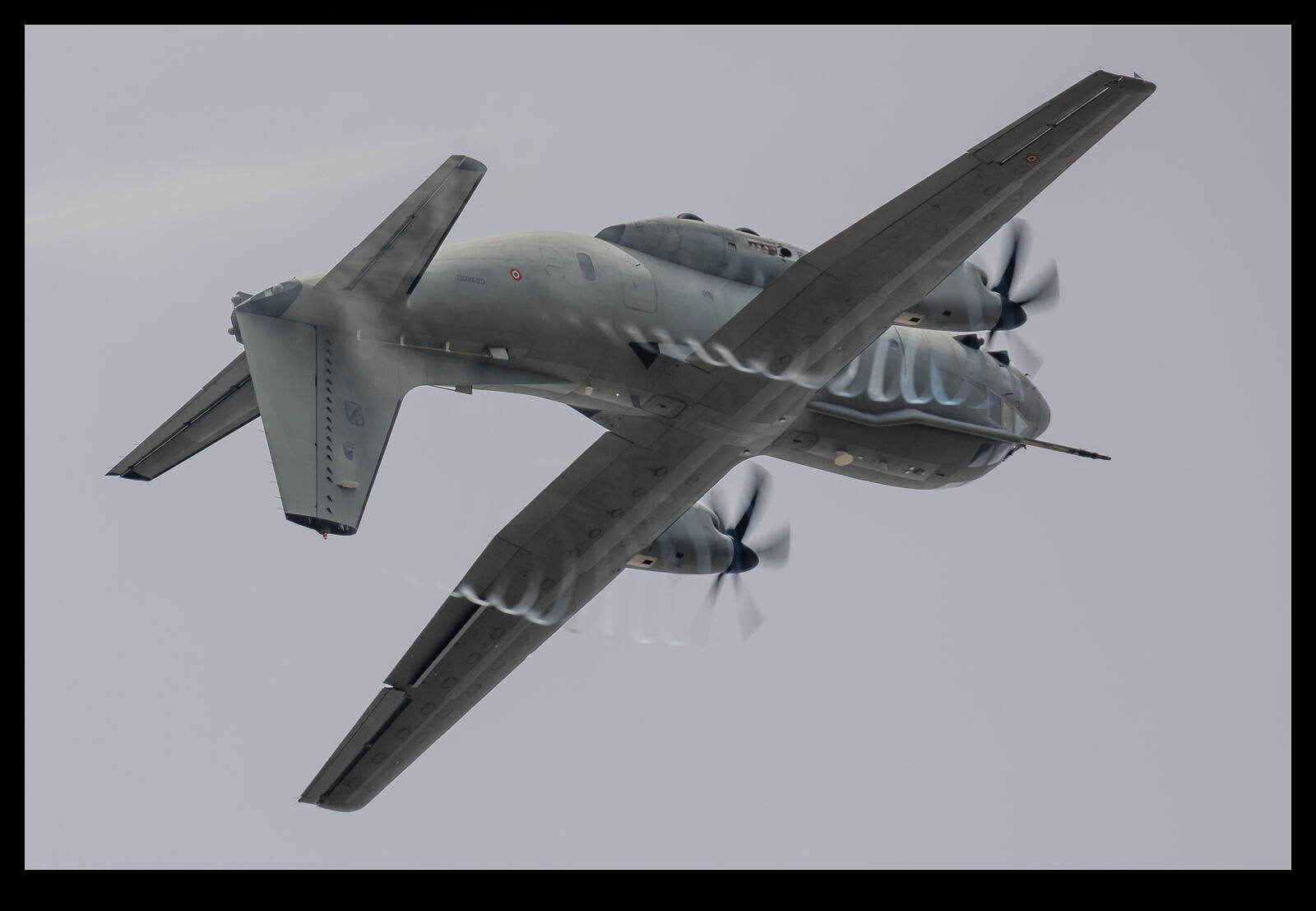 I have seen plenty of footage of C-27J displays where the crews make use of the plentiful power of the type to undertake aerobatics. However, I had never seen it in person. The only C-27Js I had seen display were from the US Coast Guard and they were much more benign in their performance. RIAT brought an example from the Italian Air Force’s test centre and the crew that displayed it knew exactly how much performance they could wring from it.
I have seen plenty of footage of C-27J displays where the crews make use of the plentiful power of the type to undertake aerobatics. However, I had never seen it in person. The only C-27Js I had seen display were from the US Coast Guard and they were much more benign in their performance. RIAT brought an example from the Italian Air Force’s test centre and the crew that displayed it knew exactly how much performance they could wring from it.
 They displayed a few times during the show, and each performance was worth stopping to watch. The ability to loop and roll a decent sized transport was impressive. The conditions during some of the displays were not ideal from a lighting point of view but the humidity in the air did make for some great prop vortices. An inverted plane streaming vapour from the props makes for an interesting image. If you haven’t had the chance to see the display and an opportunity presents itself, do be there.
They displayed a few times during the show, and each performance was worth stopping to watch. The ability to loop and roll a decent sized transport was impressive. The conditions during some of the displays were not ideal from a lighting point of view but the humidity in the air did make for some great prop vortices. An inverted plane streaming vapour from the props makes for an interesting image. If you haven’t had the chance to see the display and an opportunity presents itself, do be there.
Sensors Versus Markings on the Gripen E
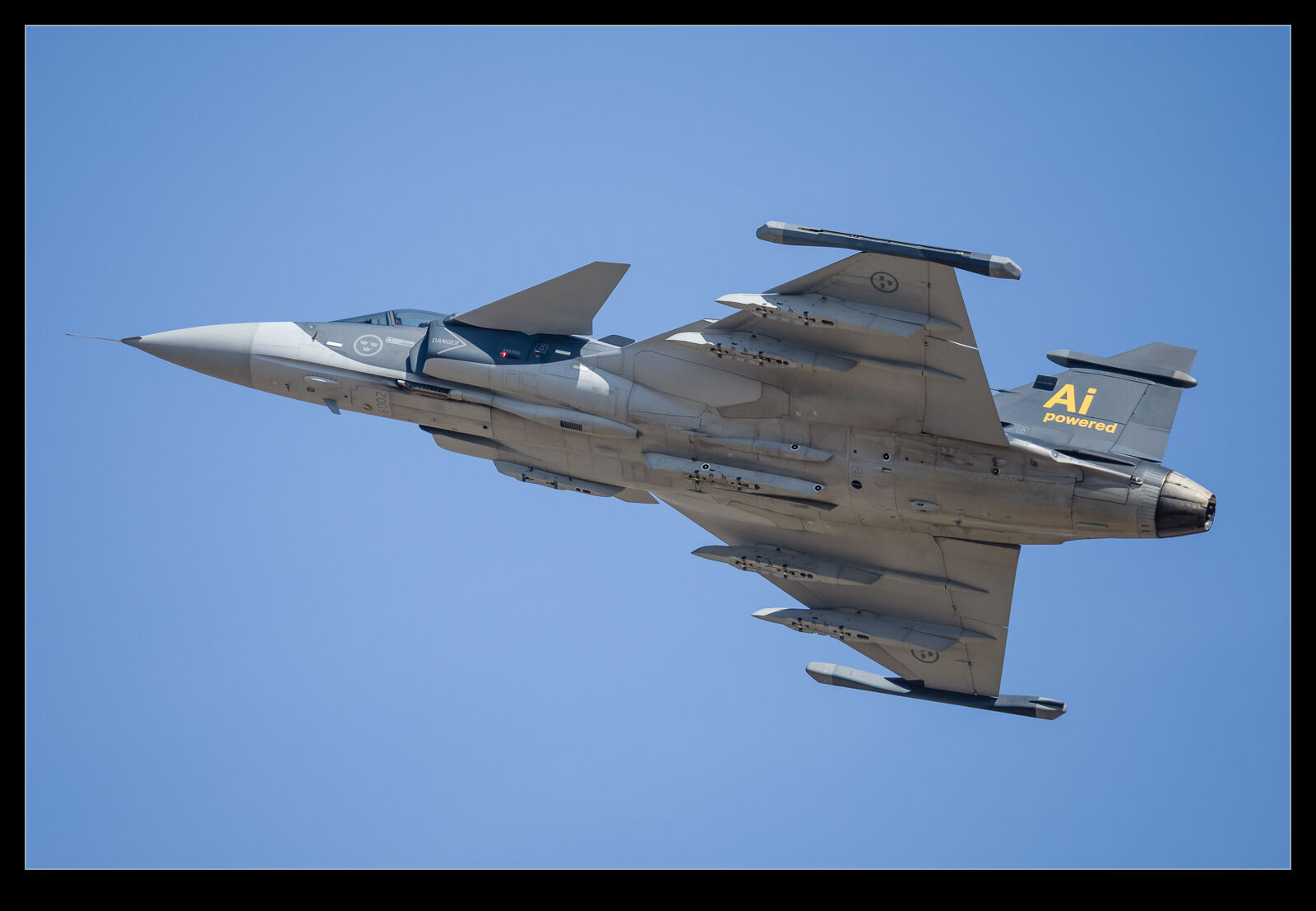 I was editing my images from RIAT recently and culling those that were never going to see the light of day. As I was working through the images of the Gripen E demonstrations, I noticed an array of sensors on the fuselage of the aircraft. There were also a bunch of markings that looked quite similar. The sensors seemed to have a specific shaping to the fuselage to align them with where they needed to face whilst the markings just seemed painted on to both the fuselage and the pylons. My assumption was that these were tracking locations for stores separation tests, but they were different to what I have seen used for this previously. I can’t tell for sure whether one is designed to distract you from the other! I have no knowledge of the systems fitted to the Gripen and will have to do some research but once you see this array of sensors, you can’t help but notice them thereafter!
I was editing my images from RIAT recently and culling those that were never going to see the light of day. As I was working through the images of the Gripen E demonstrations, I noticed an array of sensors on the fuselage of the aircraft. There were also a bunch of markings that looked quite similar. The sensors seemed to have a specific shaping to the fuselage to align them with where they needed to face whilst the markings just seemed painted on to both the fuselage and the pylons. My assumption was that these were tracking locations for stores separation tests, but they were different to what I have seen used for this previously. I can’t tell for sure whether one is designed to distract you from the other! I have no knowledge of the systems fitted to the Gripen and will have to do some research but once you see this array of sensors, you can’t help but notice them thereafter!
Portugal’s Merlins Just Look Better
 The AW101 is a great looking helicopter. I saw the original prototypes fly in the late ‘80s and early ‘90s including one that was configured as a civilian passenger type (sadly never to have the demand to make it to production). Since that time, I have liked to get photos of them wherever possible. The Canadian Cormorants look great in their yellow paint, and I finally got shots of them last year. Normally they are not painted in a very exciting way.
The AW101 is a great looking helicopter. I saw the original prototypes fly in the late ‘80s and early ‘90s including one that was configured as a civilian passenger type (sadly never to have the demand to make it to production). Since that time, I have liked to get photos of them wherever possible. The Canadian Cormorants look great in their yellow paint, and I finally got shots of them last year. Normally they are not painted in a very exciting way.
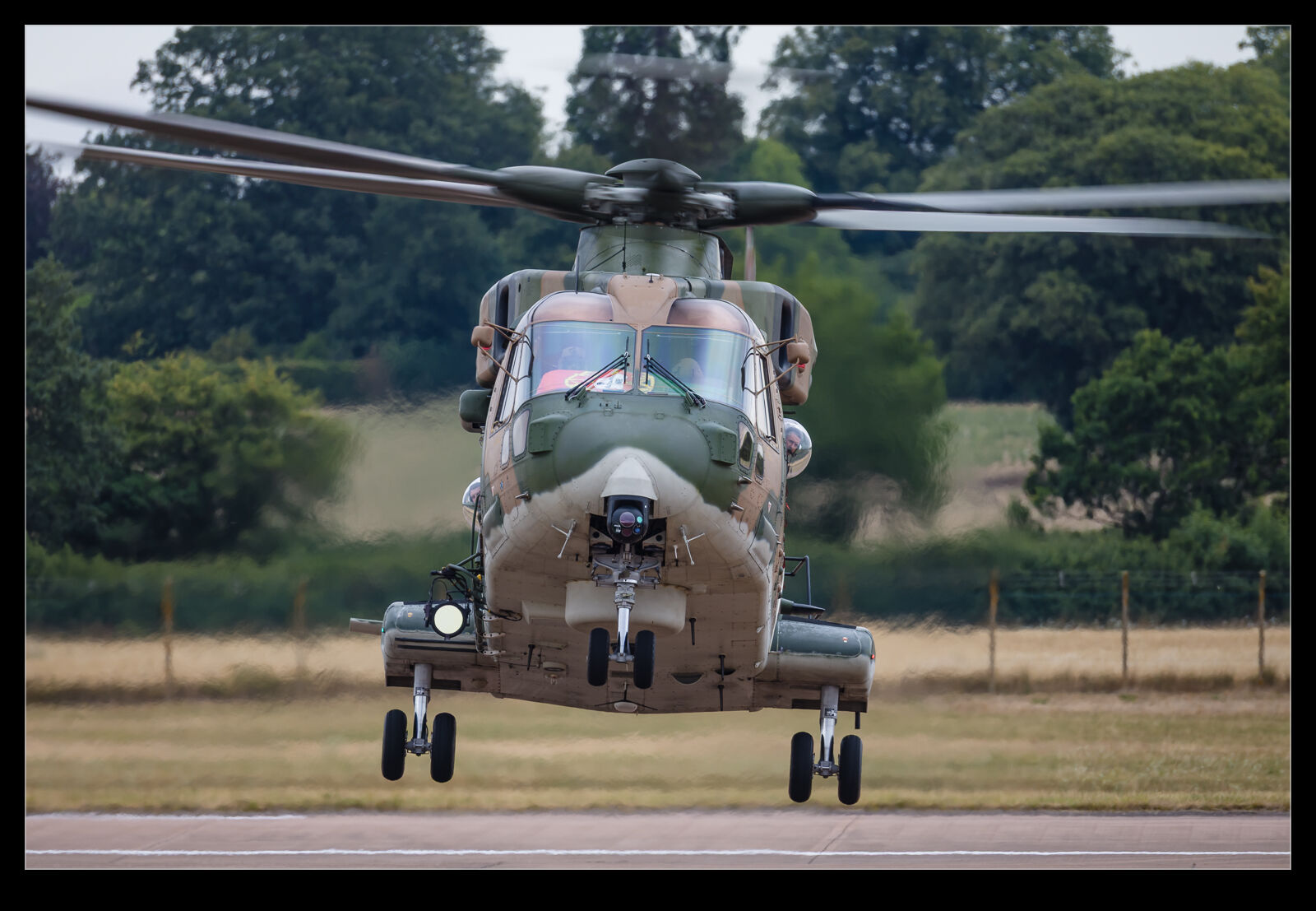 However, the Portuguese Merlin came to display at RIAT this year and it was way better looking than the average. It has a camouflage finish which seems to be a rarity these days. The colours of the camo were also quite vibrant, and it made for a striking subject. It certainly helped that the crew were throwing it around quite energetically and performed on more than one occasion, so I got plenty of shots of it.
However, the Portuguese Merlin came to display at RIAT this year and it was way better looking than the average. It has a camouflage finish which seems to be a rarity these days. The colours of the camo were also quite vibrant, and it made for a striking subject. It certainly helped that the crew were throwing it around quite energetically and performed on more than one occasion, so I got plenty of shots of it.
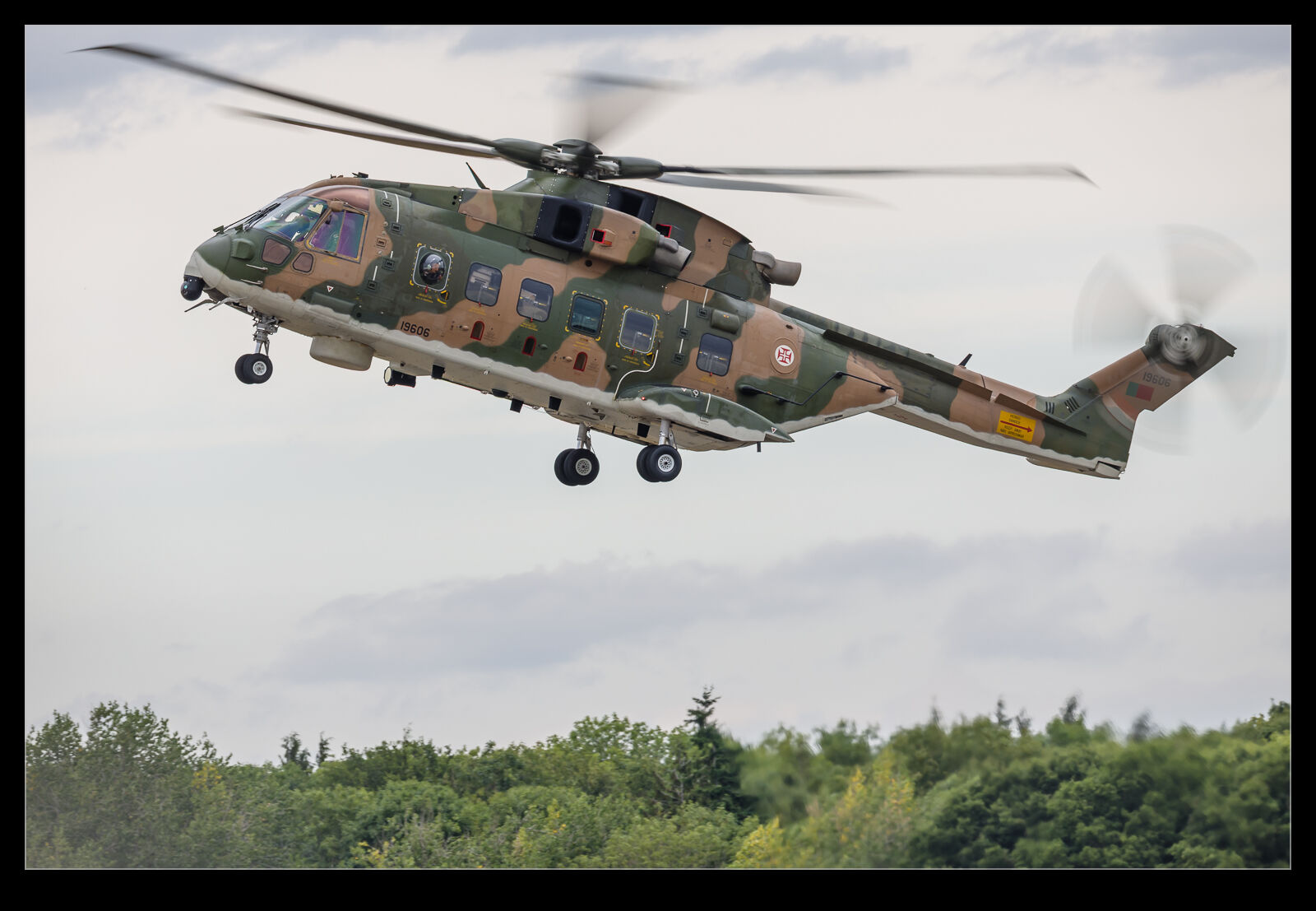 An air show is an opportunity to see an airframe performing in ways that you wouldn’t normally get but it is also a rather sterile environment. These helicopters are used for search and rescue along the coastline of Portugal, and I imagine it would be really nice to get to photograph them in their “natural habitat” with cliffs and the see behind them. Maybe I might find myself out there one day.
An air show is an opportunity to see an airframe performing in ways that you wouldn’t normally get but it is also a rather sterile environment. These helicopters are used for search and rescue along the coastline of Portugal, and I imagine it would be really nice to get to photograph them in their “natural habitat” with cliffs and the see behind them. Maybe I might find myself out there one day.
Apparently, This Helicopter is Very Rare
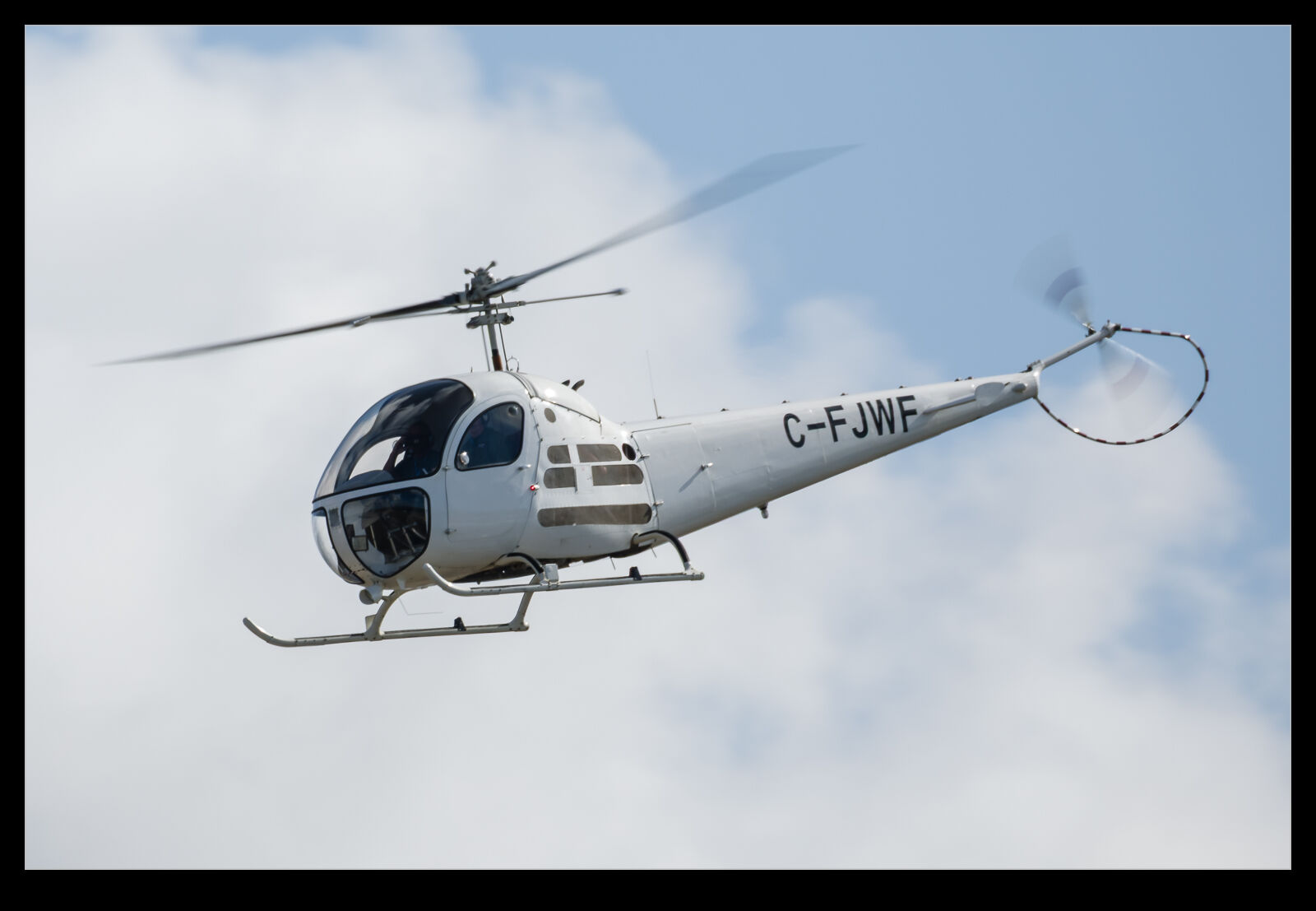 While the majority of aircraft that appear at RIAT are military, you do get some civilian types that show up as well. This year, one of these was a Canadian registered Bell 47. This airframe is a Bell 47H-1 which I am informed is a pretty rare member of the larger family. No idea whether this is true or whether these things are common as muck. I certainly haven’t got a pile of shots of similar airframes but that is hardly proof. Given that it is registered in Canada, I am not sure how much time it is spending in the UK, but it was here and flying so that’ll do!
While the majority of aircraft that appear at RIAT are military, you do get some civilian types that show up as well. This year, one of these was a Canadian registered Bell 47. This airframe is a Bell 47H-1 which I am informed is a pretty rare member of the larger family. No idea whether this is true or whether these things are common as muck. I certainly haven’t got a pile of shots of similar airframes but that is hardly proof. Given that it is registered in Canada, I am not sure how much time it is spending in the UK, but it was here and flying so that’ll do!
Is This Wildcat Carrying Enough?
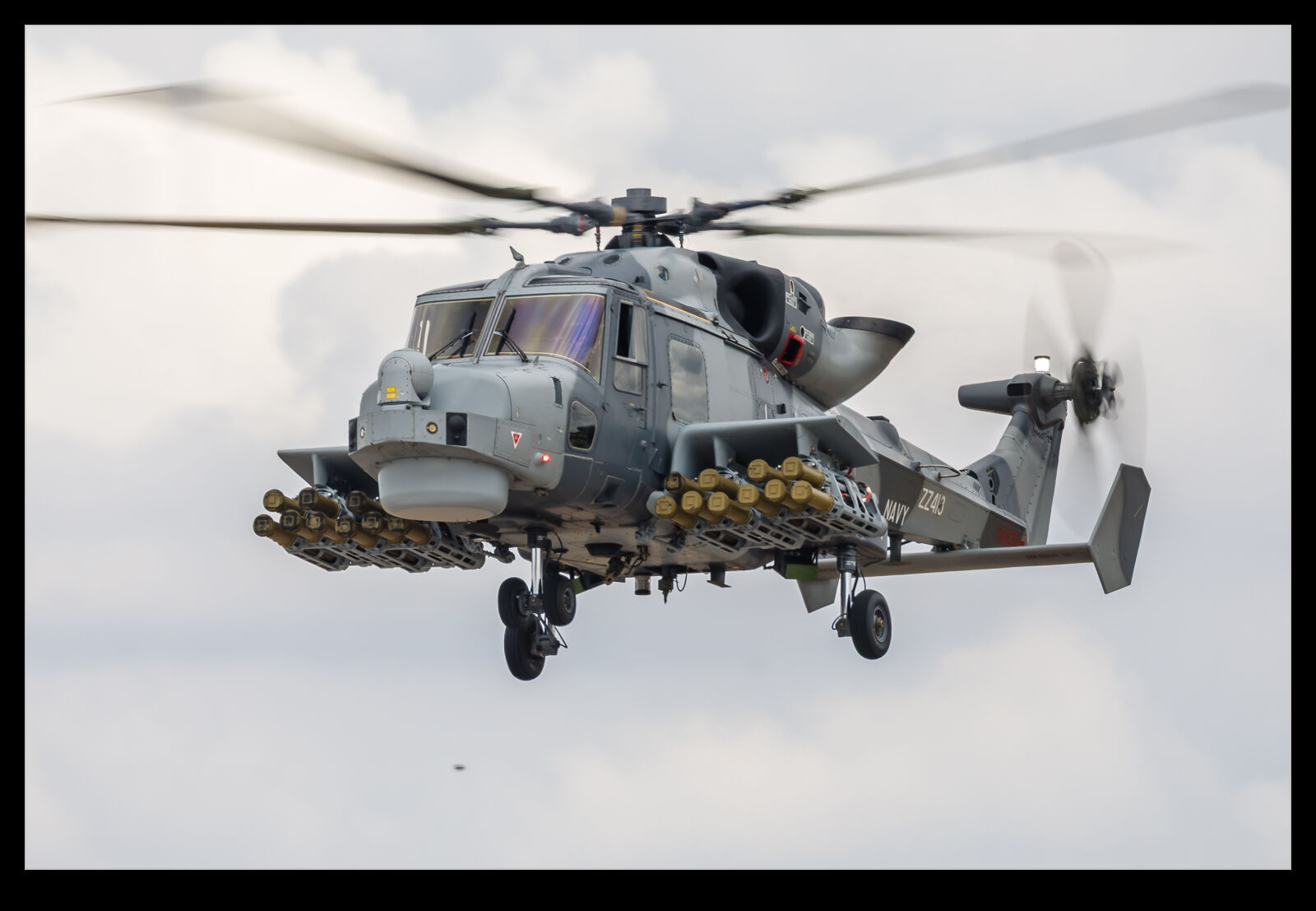 RIAT was visited by a number of AW159 Wildcats for the show. The Navy and Army brought examples with the Navy showing theirs as part of the Black Cats team. Midway through the show, another Navy example showed up. Unlike the others, this one was carrying external stores. The original Lynx looked heavily loaded if it was carrying four Sea Skuas, but this one really did look like it was ready for anything. I’m not sure if this is the Martlet missile installation or something else but, whatever it is, there was no shortage of capability on display.
RIAT was visited by a number of AW159 Wildcats for the show. The Navy and Army brought examples with the Navy showing theirs as part of the Black Cats team. Midway through the show, another Navy example showed up. Unlike the others, this one was carrying external stores. The original Lynx looked heavily loaded if it was carrying four Sea Skuas, but this one really did look like it was ready for anything. I’m not sure if this is the Martlet missile installation or something else but, whatever it is, there was no shortage of capability on display.
An E-3F For the First Time for Me
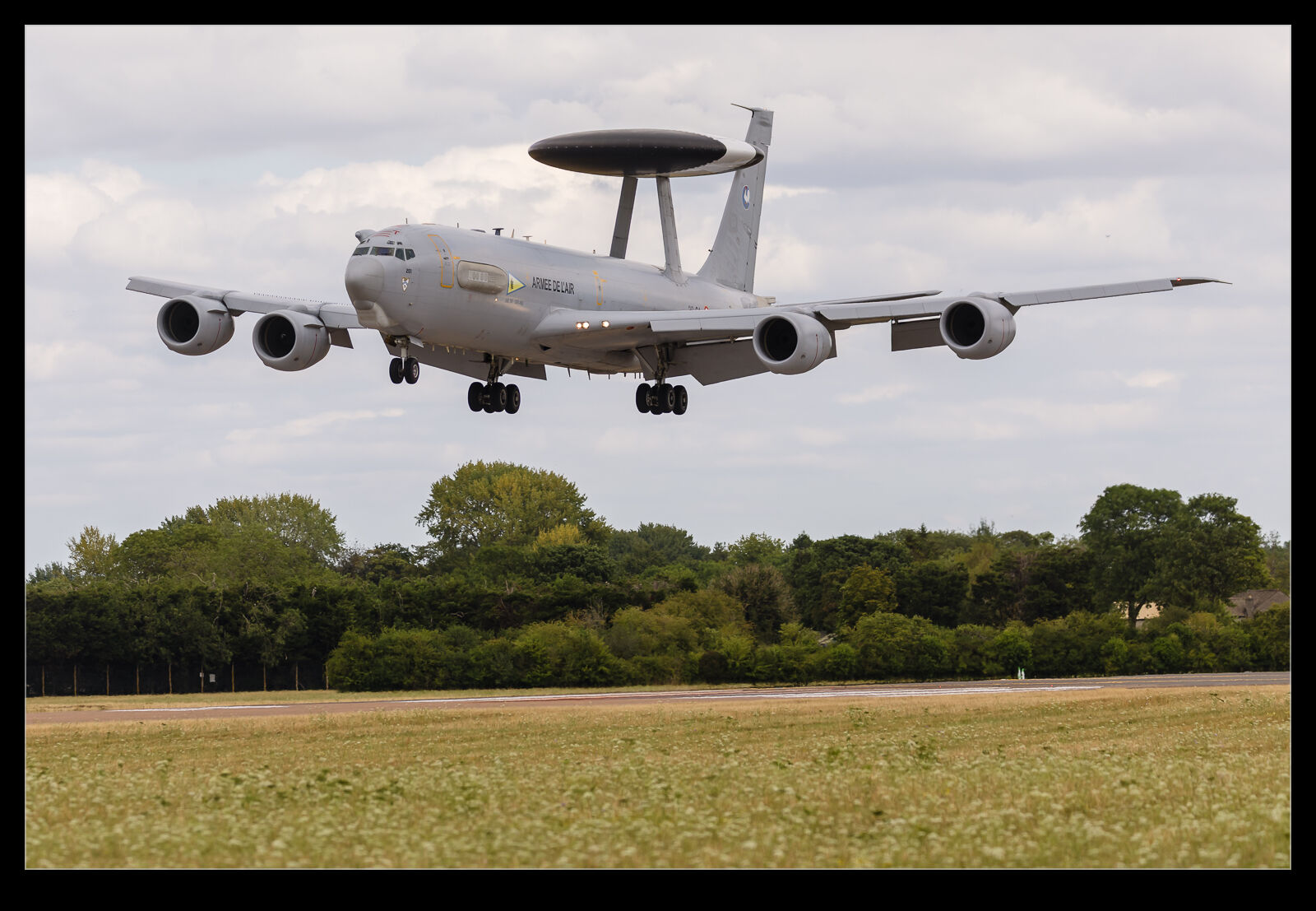 The early 90s had both the RAF and the French Air Force buying new airborne early warning aircraft in the form of the E-3. Unlike the USAF and NATO jets, these included the upgrade to the CFM56 engines which improved endurance and performance. I saw the RAF’s jets on many occasions but never encountered a French jet until this year – after the RAF jets have been retired and not long before the French ones follow suit. I’m not sure how much longer they have but seeing one arriving and departing the show was a nice result. I was pretty happy that I happened to be at the arrival end when it came in which was a bonus.
The early 90s had both the RAF and the French Air Force buying new airborne early warning aircraft in the form of the E-3. Unlike the USAF and NATO jets, these included the upgrade to the CFM56 engines which improved endurance and performance. I saw the RAF’s jets on many occasions but never encountered a French jet until this year – after the RAF jets have been retired and not long before the French ones follow suit. I’m not sure how much longer they have but seeing one arriving and departing the show was a nice result. I was pretty happy that I happened to be at the arrival end when it came in which was a bonus.
An Original Lynx is Welcome
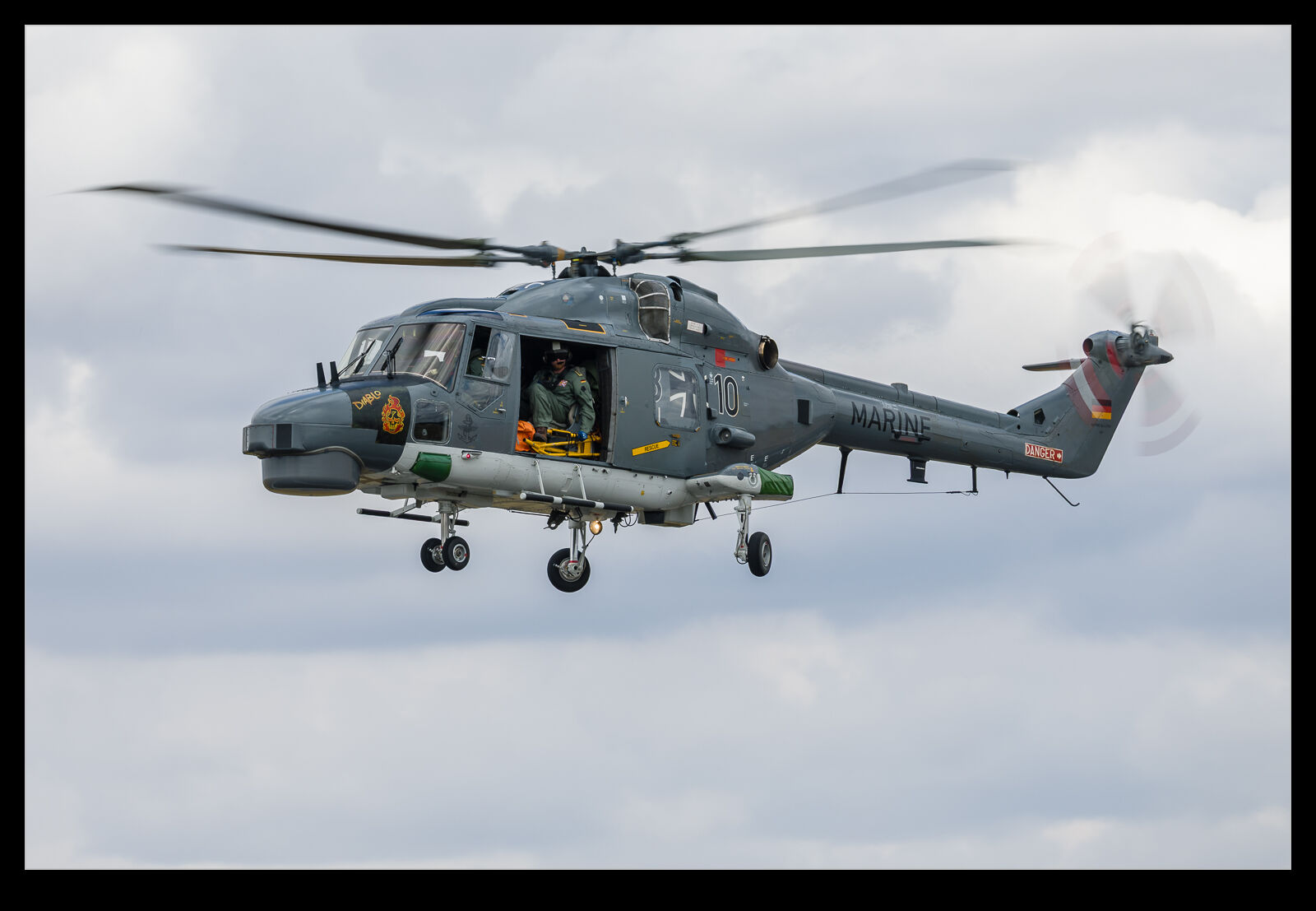 The Westland Lynx was a popular type and it sold well around the world. However, time has moved on and many operators have replaced their examples. The AW159 Wildcat has been the successor in some operators but other types have replaced them for most countries. Having an original Lynx still in use is a nice treat and the German Navy has not yet replaced all of theirs. They brought one to RIAT this year and the smooth lines of the original design are relatively untouched on their versions. They will soon be gone so this was a good opportunity to see one again.
The Westland Lynx was a popular type and it sold well around the world. However, time has moved on and many operators have replaced their examples. The AW159 Wildcat has been the successor in some operators but other types have replaced them for most countries. Having an original Lynx still in use is a nice treat and the German Navy has not yet replaced all of theirs. They brought one to RIAT this year and the smooth lines of the original design are relatively untouched on their versions. They will soon be gone so this was a good opportunity to see one again.
The Atlantique is a Great Throwback
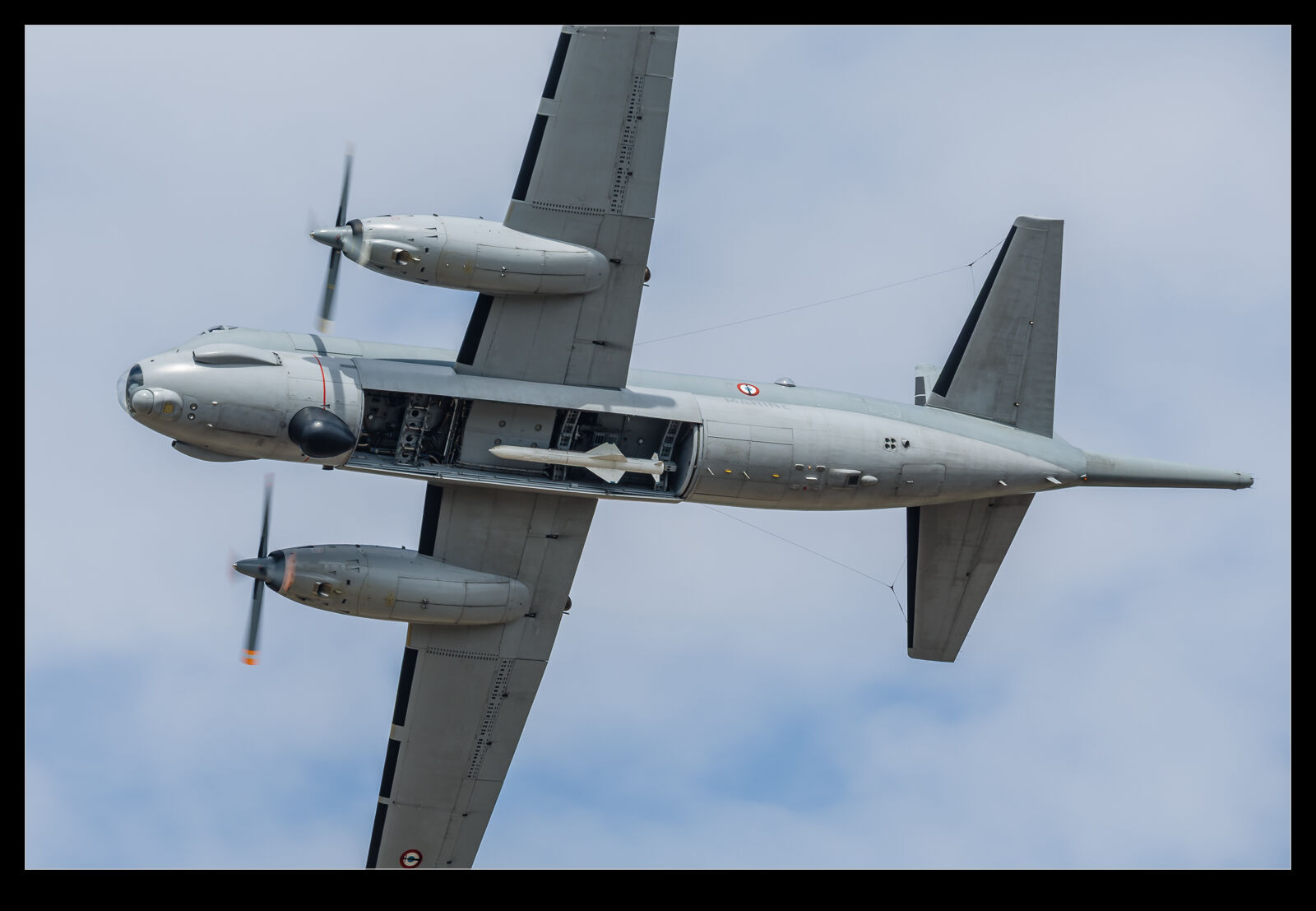 RIAT provided many high points for me this year. One of the types I haven’t seen for a long time was the Atlantique operated by the French Navy. I think I last saw one at Mildenhall at an Air Fete at the beginning of the 90s. Not only was the plane on the ground but it was also taking part in the flying display. Powered by a pair of Tyne turboprops, the engine whine on the ground is quite painful. You do need to give your ears some protection to avoid it getting too much. Once those engines are ramped up to take off power, the humid conditions meant some nice prop vortices showed up.
RIAT provided many high points for me this year. One of the types I haven’t seen for a long time was the Atlantique operated by the French Navy. I think I last saw one at Mildenhall at an Air Fete at the beginning of the 90s. Not only was the plane on the ground but it was also taking part in the flying display. Powered by a pair of Tyne turboprops, the engine whine on the ground is quite painful. You do need to give your ears some protection to avoid it getting too much. Once those engines are ramped up to take off power, the humid conditions meant some nice prop vortices showed up.
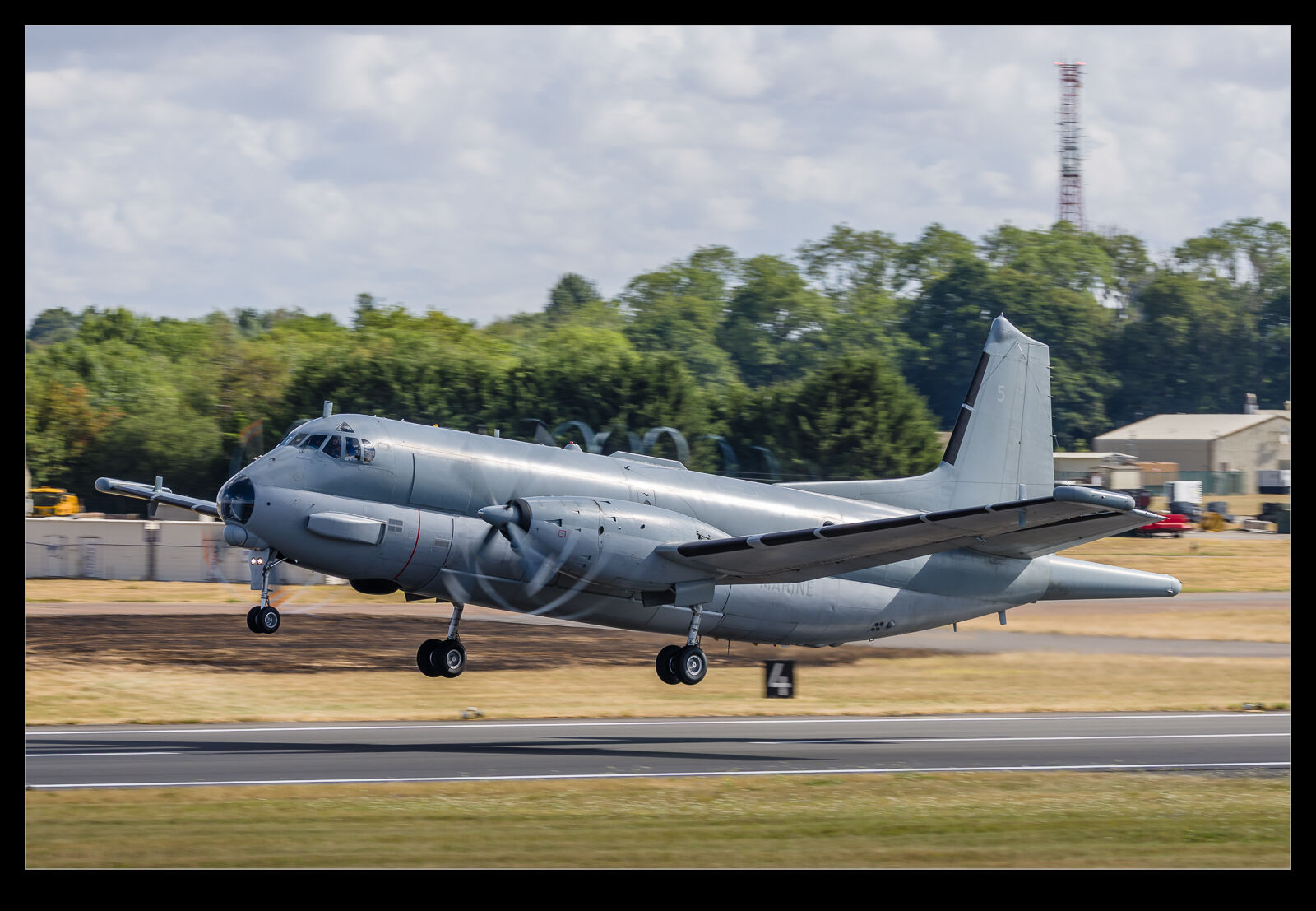 The display consisted of a number of passes. There is a radar installation that retracts into the fuselage for take off and landing as well as when it isn’t needed and drag reduction is more valuable. For some of the passes this radar was extended. Also, there is a large underfuselage weapons bay and the doors to this were opened to reveal a captive Exocet missile. The Exocet is a large weapon, and you really appreciate that when it is shown against a plane as large as the Atlantique. The French Navy is planning on introducing a new type based on a Falcon business jet so the chances to see an Atlantique will be diminishing soon.
The display consisted of a number of passes. There is a radar installation that retracts into the fuselage for take off and landing as well as when it isn’t needed and drag reduction is more valuable. For some of the passes this radar was extended. Also, there is a large underfuselage weapons bay and the doors to this were opened to reveal a captive Exocet missile. The Exocet is a large weapon, and you really appreciate that when it is shown against a plane as large as the Atlantique. The French Navy is planning on introducing a new type based on a Falcon business jet so the chances to see an Atlantique will be diminishing soon.
Take a Look at That Wing Span
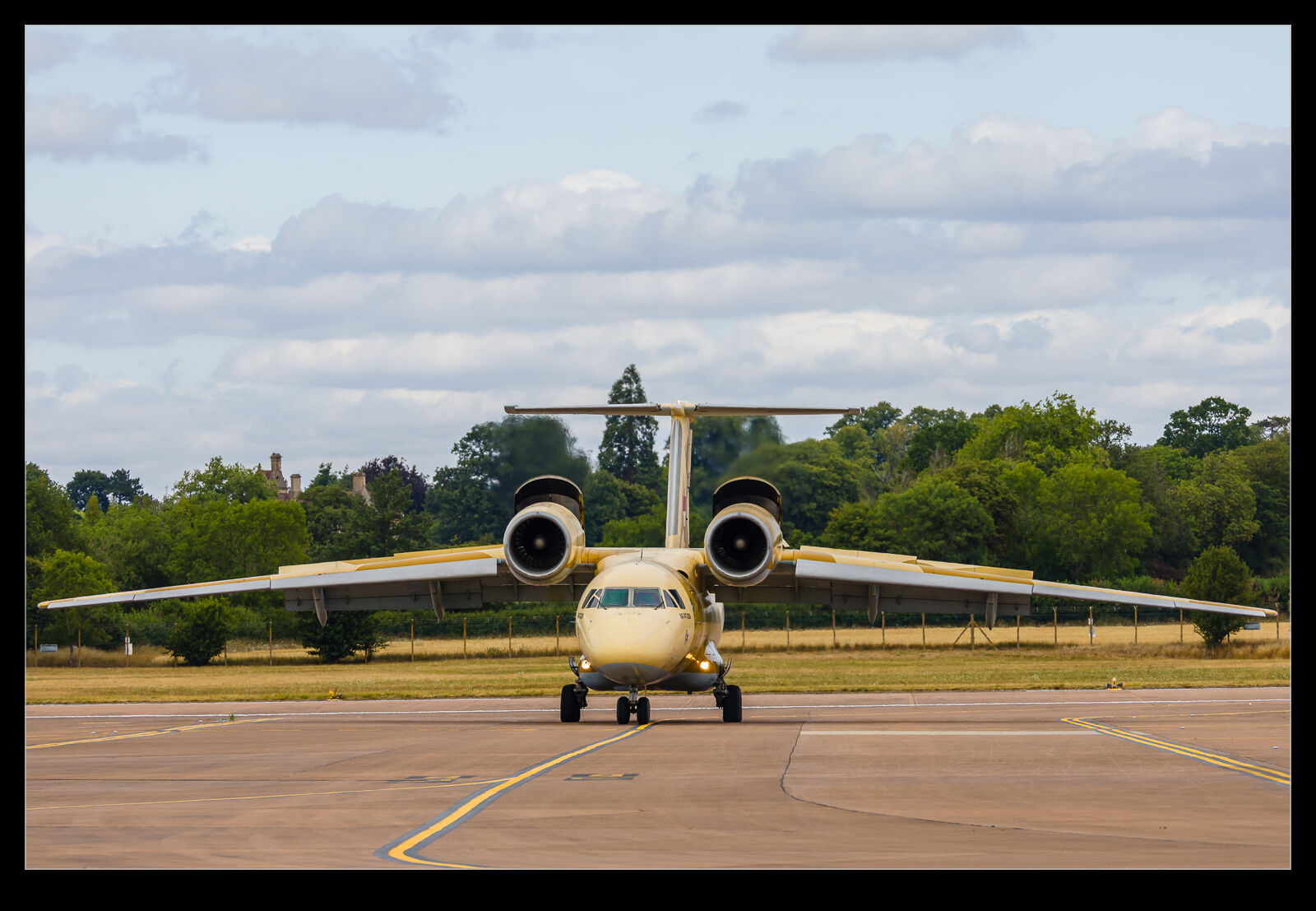 Back around 1990, I saw an Antonov AN-72 at the Farnborough show. This was the time as the wall came down and eastern bloc aircraft started to appear at shows. After that, I don’t think I saw one again. That changed at RIAT this year when the Egyptian Air Force brought an AN-74 – an updated version of the original Coaler. The feature of this plane that gets lots of attention is the location of the engines. They are mounted above the wing and employ upper surface blowing. The exhaust from the engines is entrained but the upper surface of the wing which increases the lift and reduces approach and take off speed.
Back around 1990, I saw an Antonov AN-72 at the Farnborough show. This was the time as the wall came down and eastern bloc aircraft started to appear at shows. After that, I don’t think I saw one again. That changed at RIAT this year when the Egyptian Air Force brought an AN-74 – an updated version of the original Coaler. The feature of this plane that gets lots of attention is the location of the engines. They are mounted above the wing and employ upper surface blowing. The exhaust from the engines is entrained but the upper surface of the wing which increases the lift and reduces approach and take off speed.
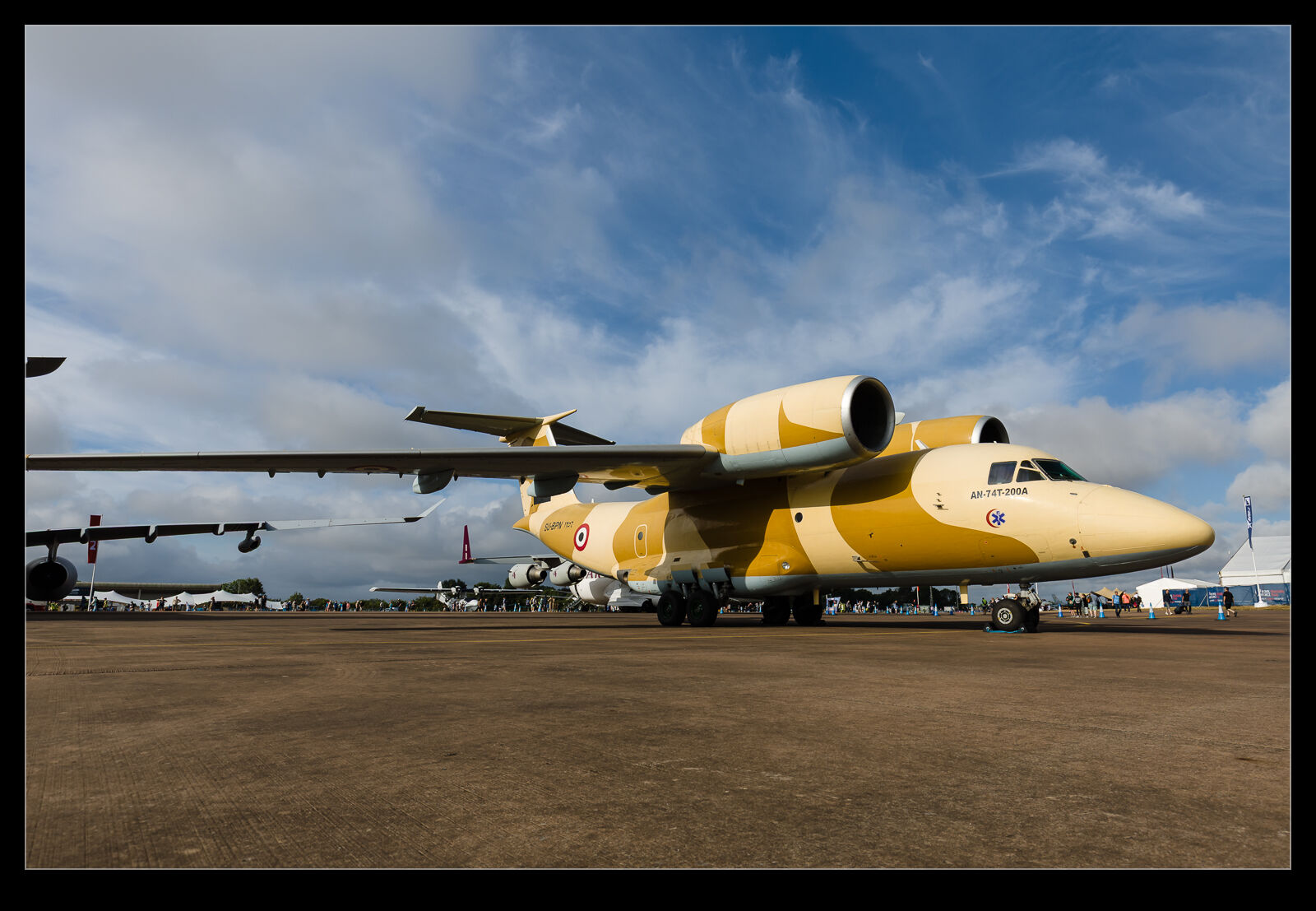 However, the thing I had never appreciated before seeing the plane at Fairford was the span of the wing on this plane. When it taxied in towards us, I got a view of it head on which showed just how large the span is. It is massive. The upper surface blowing only impacts close to the engines, so the rest of the wing is not affected. I wonder how much it matters. It was interesting when it took off at the end of the show that the takeoff run seemed quite long. It didn’t seem like a STOL aircraft. Anyway, forget all that and look at this amazing wingspan!
However, the thing I had never appreciated before seeing the plane at Fairford was the span of the wing on this plane. When it taxied in towards us, I got a view of it head on which showed just how large the span is. It is massive. The upper surface blowing only impacts close to the engines, so the rest of the wing is not affected. I wonder how much it matters. It was interesting when it took off at the end of the show that the takeoff run seemed quite long. It didn’t seem like a STOL aircraft. Anyway, forget all that and look at this amazing wingspan!
